Wondering how to spend 4 days in Istanbul? This curated Istanbul itinerary features must-sees, alternative neighbourhoods, and immersive culinary and cultural experiences.
Dersaadet. The ‘Gate to happiness’ or ‘Door to bliss’ is just one of Istanbul’s many nicknames. To me, it’s the perfect sobriquet for a city that is like a portal: Open her up just a few inches, and Istanbul will invite you in to inhabit her for as long as you dare.
Europe’s biggest city and one of the world’s great metropolises, Istanbul is a juggernaut. With a toe in both Europe and Asia, she’s an intoxicating jumble of histories, cultures and influences (much like Tbilisi, just on a much, much bigger scale).
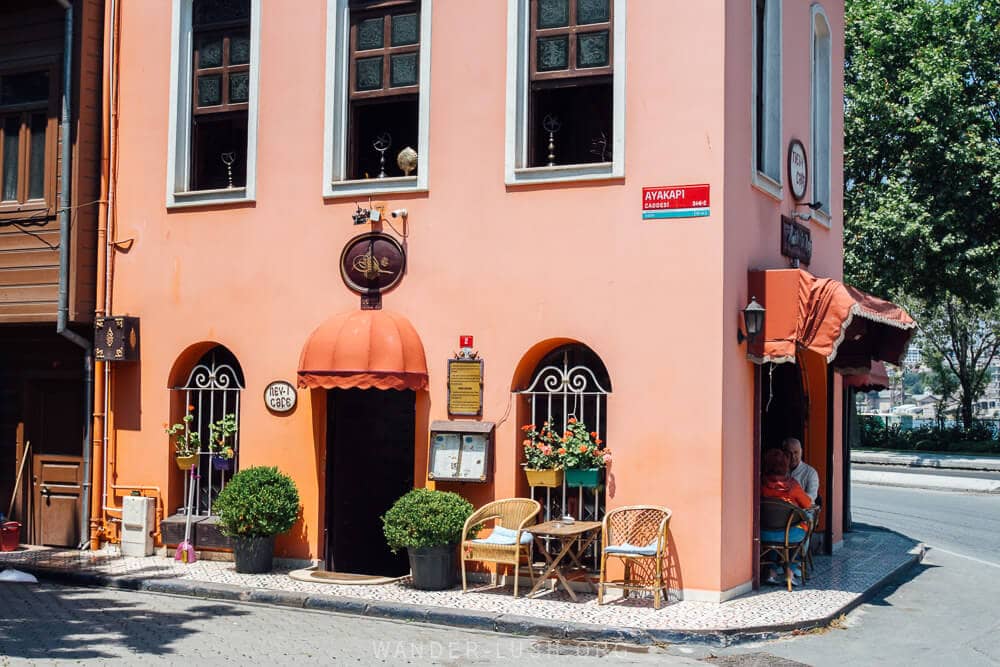
On my most recent visit to Turkey (Türkiye), I enjoyed a blissful 10 days in Istanbul. For this guide, I’ve distilled my favourite experiences into an easy to follow and comprehensive Istanbul 4 day itinerary.
We’ll cover a dozen neighbourhoods and districts, a slew of must-sees, and a veritable buffet of foodie gems. You’ll see Ottoman-era mansions and colourful row houses, ride on historic trams and local ferries, visit magnificent mosques and a community garden, leaf through comely antique shops, experience the Whirling Dervishes like never before, and eat the best breakfast Istanbul has to offer.
Here is how to spend 4 days in Istanbul, Turkey.
Please note: This post contains affiliate links, meaning I may earn a commission if you make a purchase by clicking a link (at no extra cost to you). Learn more.
Istanbul quick links
- Istanbul airport transfer: Private transfer from Istanbul Airport or Sabiha Gokcen (from $25)
- Where to stay in Istanbul: Hostel Le Banc (budget); 38 Hotel (mid-range); Hotel Empress Zoe (boutique); Ecole St. Pierre Hotel (luxury)
- Istanbul Official E-Pass: Pre-purchase online here
- Skip the line: Blue Mosque & Hagia Sophia Small-Group Tour (from $40)
- Best Istanbul food tour: Taste of 2 Continents (from $100)
- Top-rated Istanbul city tour: Best of Istanbul in 1 Day (from $60)
- Turkey car hire: Find a low-cost rental on Local Rent (from 28€/day)
Is 4 days in Istanbul enough?
Three days is the bare minimum for a first-time visitor who wants to see the highlights of Istanbul and touch on a few alternative districts. Four days in Istanbul is the ideal amount of time for a more comprehensive visit – but as you’ll see, it requires moving at a fairly fast pace.
This Istanbul itinerary focuses on the city centre. Keep in mind that there are dozens of day trip opportunities for those who want to strike out along the Bosphorus towards the Black Sea or the Princes’ Islands. With a few side trips thrown in, you could easily spend a week in Istanbul and not run out of things to do.
However many days you set aside for Istanbul, you will almost always be left wanting more. I recently spent 10 full days in the city and still didn’t get close to completing my list of to-dos.
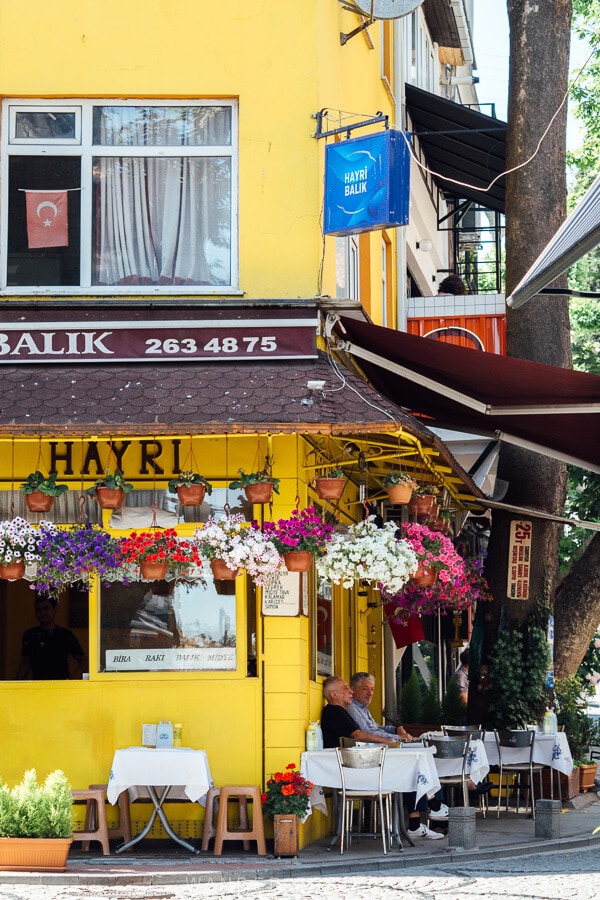
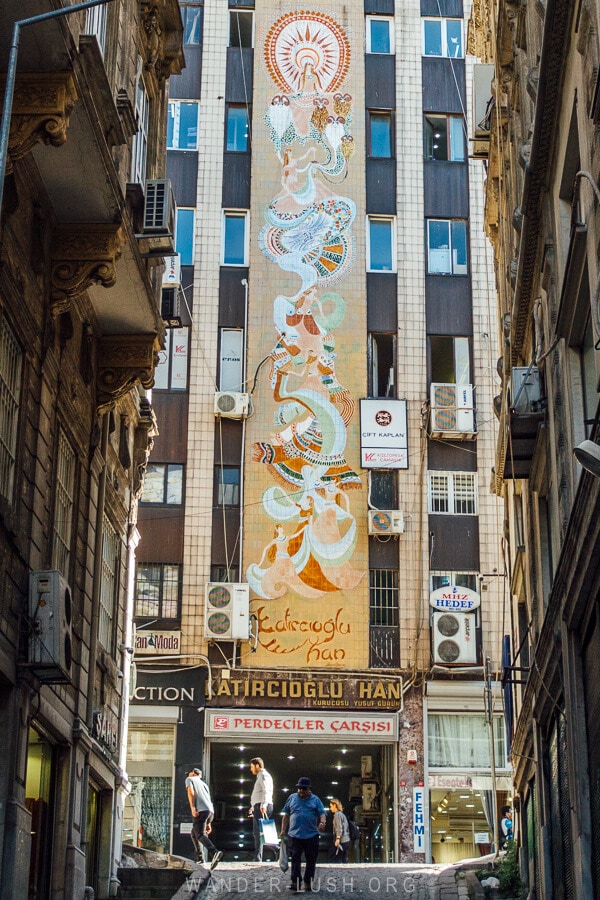
4 quick Istanbul tips
- Visit Istanbul in shoulder season: Spring (April to early June), autumn (mid-September to the start of November) or even winter are the best times of year for an Istanbul trip. Avoid summer if you can – it’s hot, overcrowded, and expensive.
- Use the Havabus/Havaist shuttle to get in from Sabiha Gokcen Airport or Istanbul Airport: It operates 24/7, with departures in both directions every 30-60 minutes. Tickets are purchased on board using cash and cost 37.50 TRY per person.
- Buy a local SIM card: Vodafone is a reliable provider. This package (the only option available to foreigners) includes 20GB of data, calls and texts, and unlimited access to Whatsapp for 350 TRY. Take a hard copy of your passport with you for registration.
- Use public transport to get around, and buy an IstanbulKart ASAP: It’s a cinch to get around Istanbul using the metro, buses, dolmus vans, trams and ferries. A rechargeable IstanbulKart can be purchased from any marked kiosk and costs 50 TRY. Two people can use the same card. A single fare with the IstanbulKart costs 7.67 TRY.
For more helpful pointers, see my 42 tips for visiting Istanbul.
Where to stay in Istanbul
Budget: Hostel Le Banc (⭐ 9.5) – This popular hostel in Beyoglu is footsteps from the Galata Tower and Sishane metro station. It features air-conditioned rooms (private doubles and mixed/all-female 4 and 10-bed dorms), a shared lounge and a terrace.
Mid-range: 38 Hotel (⭐ 8.6) – Located in Sisli, close to Osmanbey metro station, this hotel has compact, tidy double rooms and suites.
Boutique: Hotel Empress Zoe (⭐ 9.2) – This gorgeous boutique hotel is decorated with heritage flourishes and boasts hammam-like ensuites and private internal terraces. The location in Fatih, minutes from Sultan Ahmet Mosque and the Blue Mosque, is very central yet the hotel still feels secluded.
Luxury: Ecole St. Pierre Hotel (⭐ 9.5) – Located in Beyoglu close to Galata Tower, this boutique-luxury hotel offers high-end suites with private courtyards and terraces. The building, an old Italian Dominican school with remnants of the 13th-century Galata walls inside its courtyard, is dripping with history.
Istanbul 4 day itinerary overview
- Day 1: Classic Istanbul – Galata, Karakoy & the Golden Horn: Galata Tower; Bank Street; Karakoy district; the Orient Express Cafe; Gulhane Park; Topkapi Palace (optional); Hagia Sophia, the Basilica Cistern & the Blue Mosque; Grand Bazaar (optional); sunset from Galata bridge.
- Day 2: Colours of Istanbul – Fener, Balat, Ayakapi, the Spice Bazaar & Fatih: Kahvalti Turkish breakfast; Fener & Balat districts; Kariye Mosque; Saint George’s Church & Ecumenical Patriarchate; Fatih Mosque; the Spice Bazaar; authentic Whirling Dervishes ceremony in Fatih.
- Day 3: The Asian Side – Kadikoy, Kuzguncuk & Uskudar: Bosphorus ferry crossing; Kadikoy district & market; meze lunch; Uskudar Coast Walkway; Kuzguncuk district & Bostani; sunset from Camlica Hill.
- Day 4: Local Neighbourhoods – Besiktas, Arnavutkoy, Cihangir & Cukurcuma: Besiktas Breakfast Street; Sinan Pasha Mosque & the Tomb of Barbarossa; Dolmabahce Palace (optional); Cihangir & Cukurcuma districts; Arnavutkoy district; traditional Turkish hammam; Istiklal Avenue & Taksim Square.
Day 1: Classic Istanbul – Galata, Karakoy & the Golden Horn
Day 1 in Istanbul is all about the must-sees: The quintessential views, landscapes and landmarks that make Istanbul what it is. Hit the ground running and milk your first 24 hours in Istanbul for all they are worth.
Day 1 kicks off in the central Galata district. To get there, ride the metro to Sishane Station.
Start your Istanbul itinerary with panoramic views from the top of Galata Tower
Catching sight of the 67-metre-tall Galata Tower for the first time is something you never forget – whether you first spot its little peaked hat popping up above the rooftops, or you see its rotund belly silhouetted against the morning sky.
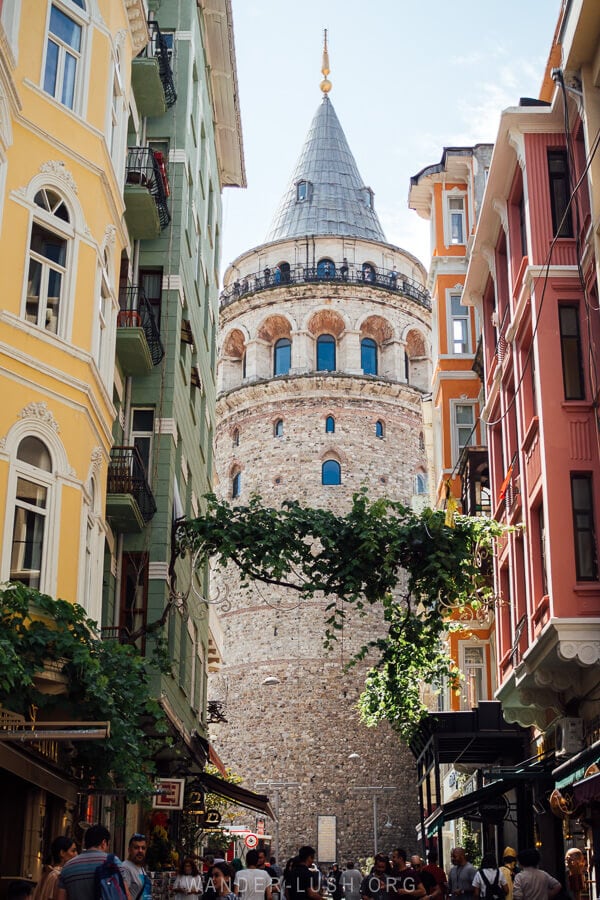
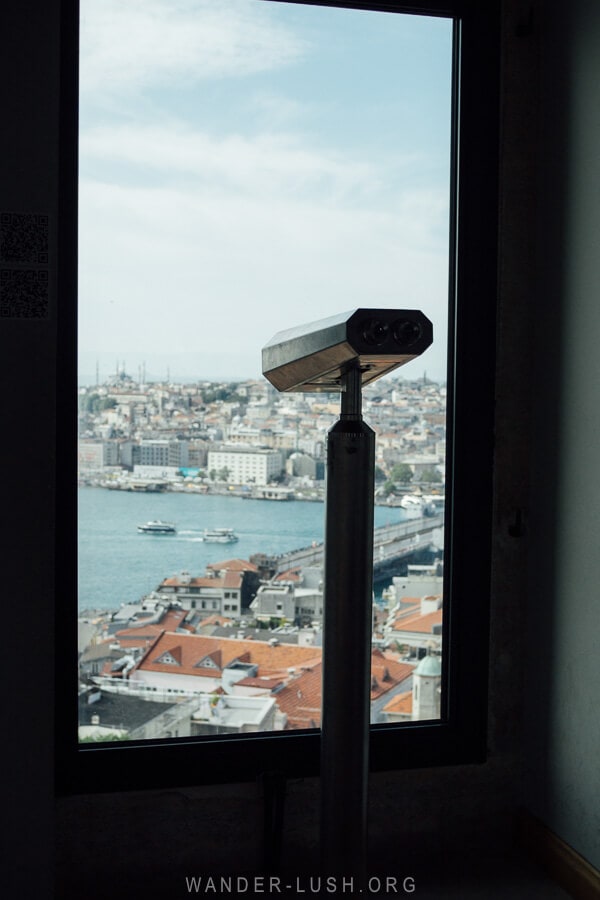
Built in 1348, the watchtower has stood sentinel over virtually every episode of Istanbul’s modern history. I can’t think of a better place to start your own Istanbul story than from the observation deck, where you can cast an eye over the entire city. Tickets are not cheap, but for me, it’s worth every lira.
Get a jump-start on the crowds by arriving just before doors open. You might get lucky and have part of the eighth-floor, open-air observation terrace – which commands views of the Bosphorus, the Golden Horn, and most of Istanbul’s major landmarks – all to yourself.

Take the spiral stairs back down, stopping to see the various artefacts and interactive exhibits that make up the new Galata Tower Museum.
- Opening hours: From 8.30am daily
- Insider tip: Pick up your Istanbul Museum Pass or Istanbul E-Pass before you leave home and get skip-the-line access to Galata Tower and 9 other museums and landmarks.
Float down the art nouveau Kamondo Stairs & take a stroll along Bankalar Caddesi (Bank Street)
Never before have I seen a fairer set of steps than the sinuous Kamondo Stairs on Voyvoda Street.
Starting near the base of Galata Tower, this shapely Art Nouveau Gaudi-esque stairway was bankrolled by Abraham Salomon Kamondo, a prominent Sephardic Jewish banker, in the 1870s. As the story goes, he commissioned them as a shortcut for his children to get to and from school. The corner-free shape was a safety measure to ensure they wouldn’t hurt themselves if they ever slipped!
At the foot of the stairs, one of Istanbul’s most beautiful streets, Bankalar Caddesi or Banks Street, reveals itself as a ribbon of stately stone facades. From the 1850s onward, this was the Ottoman answer to Wall Street; the place where the Empire housed its most important financial institutions, banks and insurance HQs.
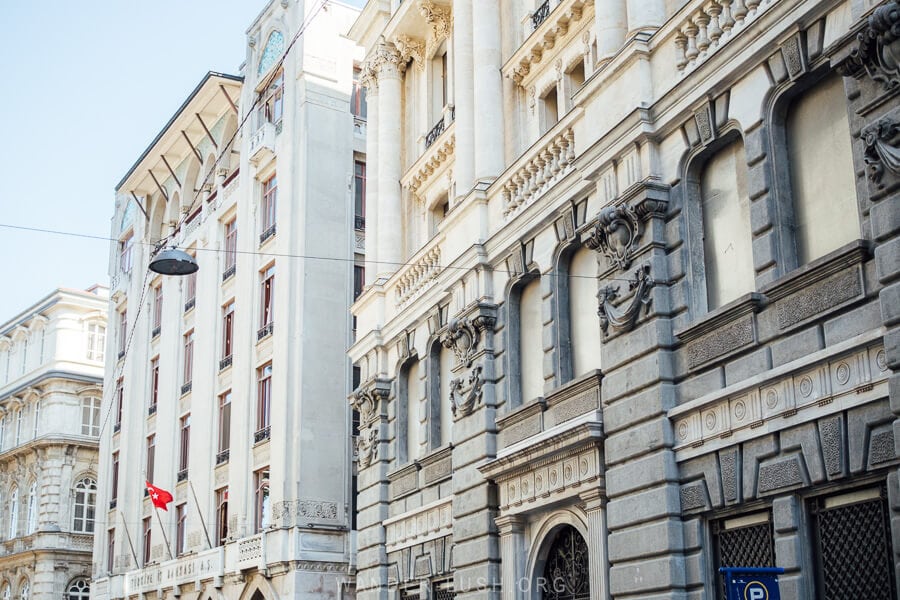
Some of the old bank buildings have been transformed into flash hotels, restaurants and community spaces. To see what these grand dames must have looked like back in the day, pop into Salt Galata (open from 11am daily; free). It is located inside the old Imperial Ottoman Bank headquarters, a Neoclassical-Oriental fusion masterpiece designed by French-Ottoman architect Alexandre Vallauri.
Salt is an innovative cultural institution dedicated to advancing art, architecture and design. The building – which is open to the public and welcomes visitors to explore free-range – contains museums, libraries, work spaces and a cafe.
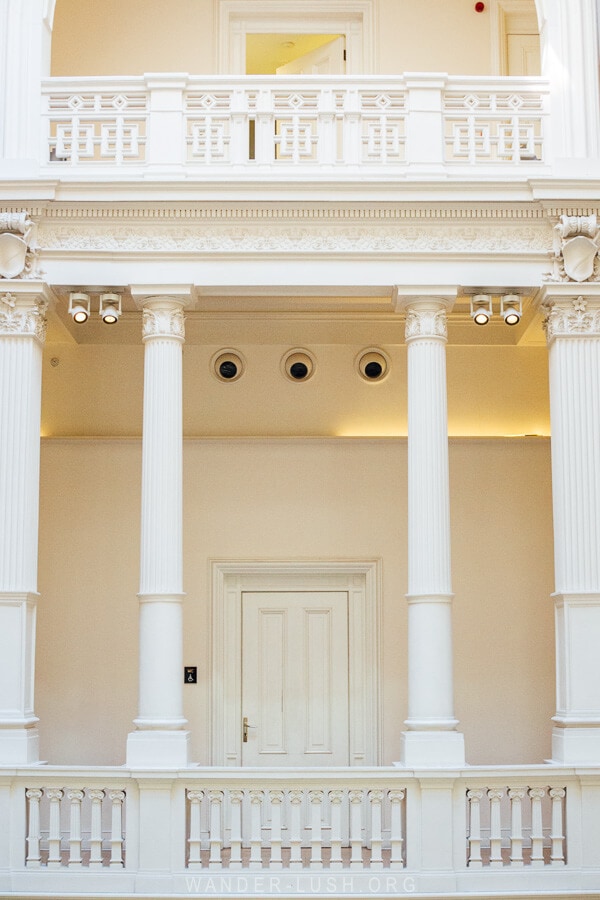
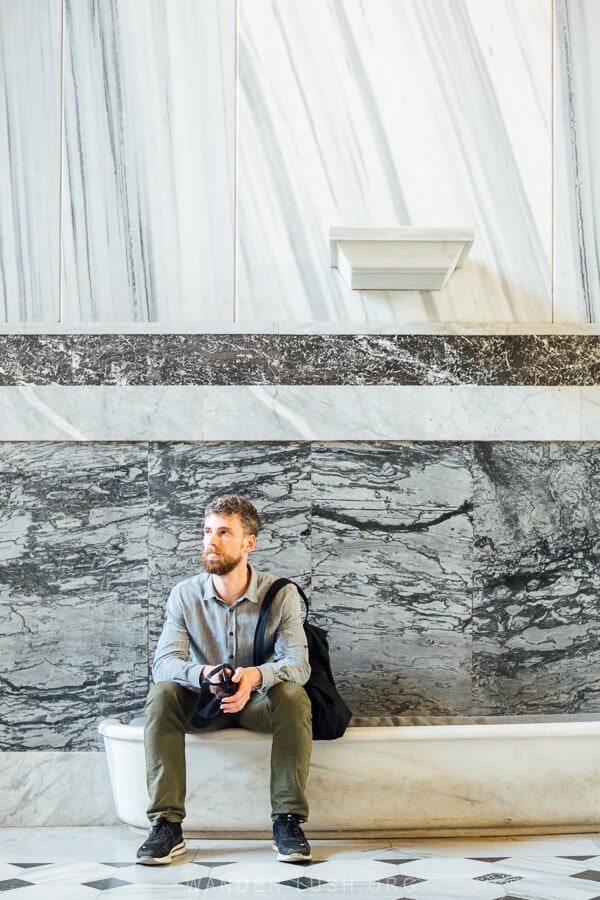
Grab a balik ekmek at Mario’s
From Banks Street, follow your nose towards the Karakoy waterfront. Fermeneciler Caddesi runs parallel to the harbour and is overrun with little shops selling hardware supplies and fishing gear. When the banks moved out, these were the industries that moved in.
Amongst the colourful nets and drill bits, there are several street food restaurants that specialise in balik ekmek (grilled fish wrap), one of Istanbul’s most delicious bites.
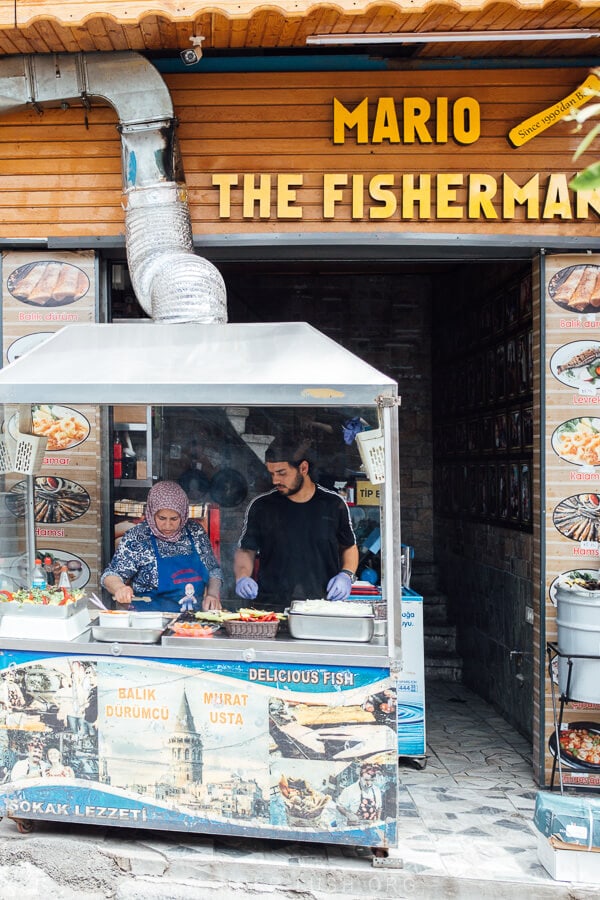

Mario The Fisherman (named for the patriarch’s likeness to the video game character) is the choice supplier of balik ekmek. Pairing charred pieces of boneless fish with lime and finished with a basting of chilli paste before serving, balik ekmek is an absolute flavour bomb. I’ve never tasted anything quite like it before. Portions are the perfect size for a substantial snack – hold back, because there is a lot more food to come.
- Location: Fermeneciler Cd. 65
- Opening hours: From 11.30am daily
- Alternative option: If you prefer a sit-down lunch, Karakoy Lokantasi is a laid-back workers’ tavern that specialises in traditional Ottoman recipes.
Explore hip Karakoy
Karakoy or ‘Black Village’ is one of Istanbul’s busiest commercial neighbourhoods. Absorbing the entire harbourside between the Galata Bridge and the new Galataport complex, its hallmark feature is a countless number of cafes, boutiques and galleries, some settled in former naval warehouses.
Take a post-lunch walk through the streets of Karakoy, heading north-east from the bridge and keeping an eager eye out for street art murals as you go.
Things to see in Karakoy:
- Karabatak Cafe, the unofficial capital of Karakoy’s coffee culture
- Hoca Tahsin Street, for street art and a photo of the colourful umbrellas hanging overhead
- The Arab Mosque (Arap Camii), one of the oldest mosques in Istanbul
- Yeralti Cami, a unique subterranean mosque
- Kilic Ali Pasha Mosque & Tophane Fountain
Gorge on Turkish baklava at Karakoy Gulluoglu
Karakoy Gulluoglu bills itself as the oldest baklava shop in Istanbul. The family-run business was established in the 1800s in Gaziantep and opened in Istanbul in 1949. The founder’s sons, grandsons, and bakers trained by the Gullu family are responsible for many of the city’s other confectionery shops.
Nestled underneath a multi-level carpark, the location is a little strange, but the cafe itself is gorgeous in an old-timey way. Stake out a table first and have a browse of the picture menu. When you’re ready, head inside.
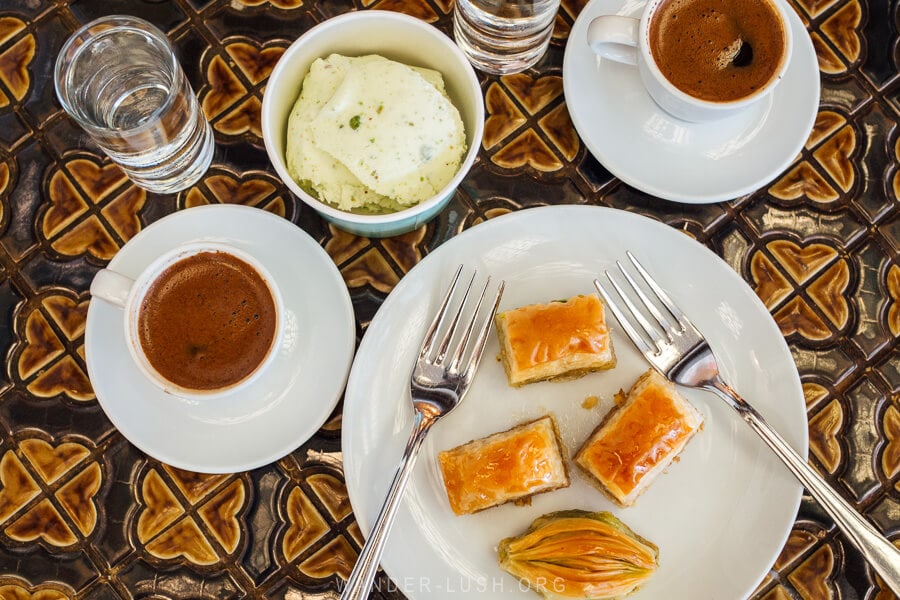
The shop is laid out like a cafeteria with different stations for different delicacies: First, choose a few diamonds and squares of baklava, available in dozens of different colours and textures, then order a scoop of chewy pistachio maras dovme dondurmasi (Turkish ice cream) and a tulip-shaped glasses of tea or ceramic cup of strong black coffee. Be sure to try the sobiyet, baklava with milk and semolina cream.
When your tray is suitably full, head to the cashier who will ring up the bill.
- Location: Kemankes Cad. 3-4
- Opening hours: 7am-1am daily (from 8am on Sundays)
Cross the bridge to visit the Istanbul Railway Museum & Orient Express Cafe
Walk off some of that sugar high by crossing the Galata Bridge on foot (walk along the bottom level near the restaurants if you want to be in the shade). Or else you can jump on the T1 tram.
The storied Sirkeci Train Station is grand both inside and out. Built in 1890 by the Oriental Railway, it served as the final stop for the fabled Orient Express train that connected Paris and Istanbul. It was still in use right up until 2009, when this route ceased operations and the final stretch of tracks were uprooted.
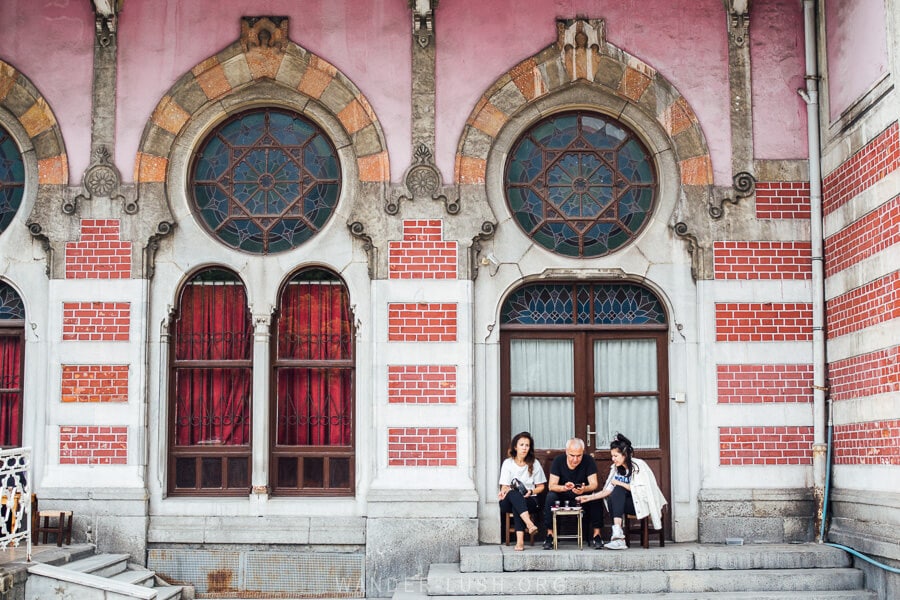
Agatha Christie fans and railway buffs alike will feel a rush setting foot on the historic platforms. You can almost see Istanbul through the eyes of a cross-continental traveller catching sight of Constantinople for the very first time.
Located inside the station, the Istanbul Railway Museum (open 10.30am-5pm weekdays; free) exhibits photographs, documents and other ephemera connected with Turkey’s railroads.
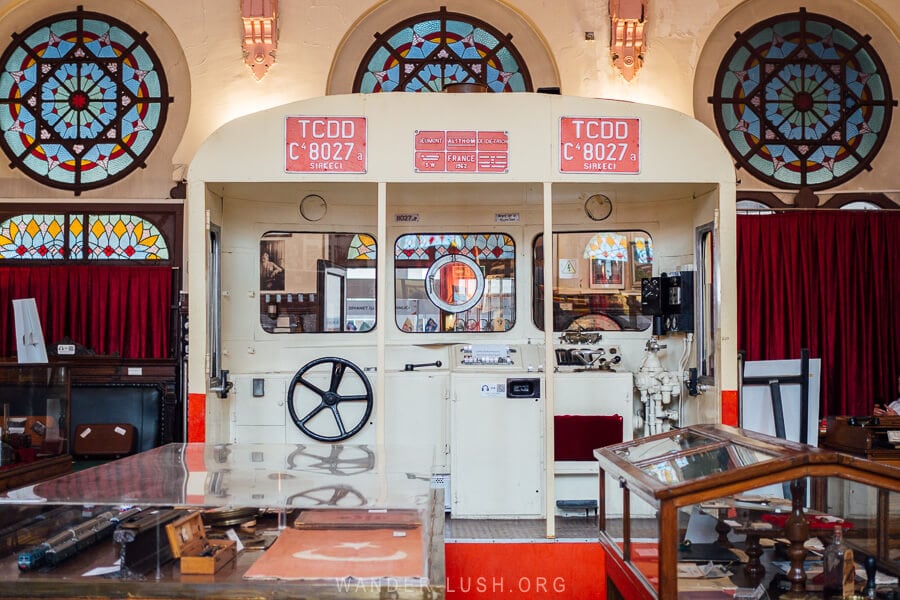
The Orient Express Cafe (open from 9am daily) is a total time-warp: Stop in for a cup of tea or a coffee on the platform, and don’t miss wandering through the very vintage dining rooms where wonderful paintings and photographs decorate the walls.
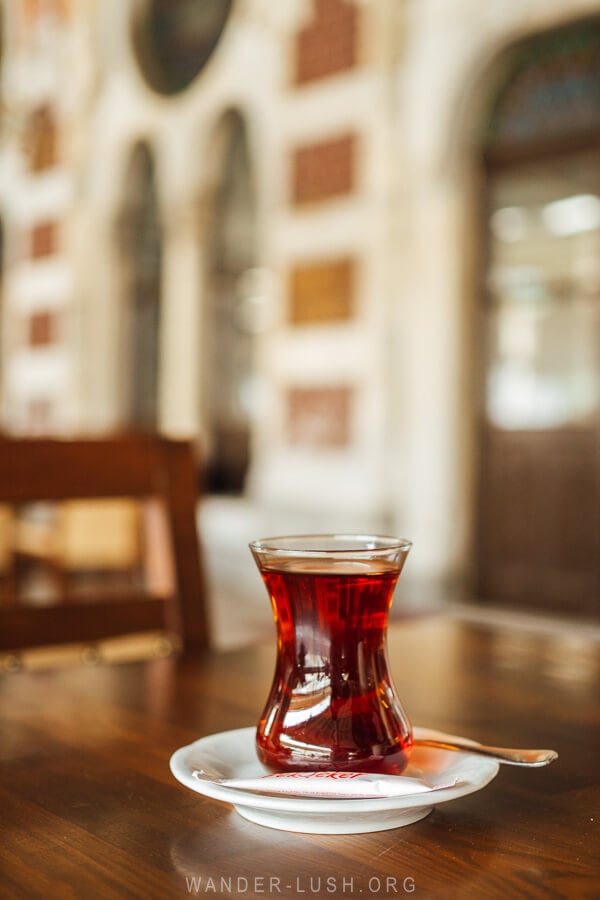
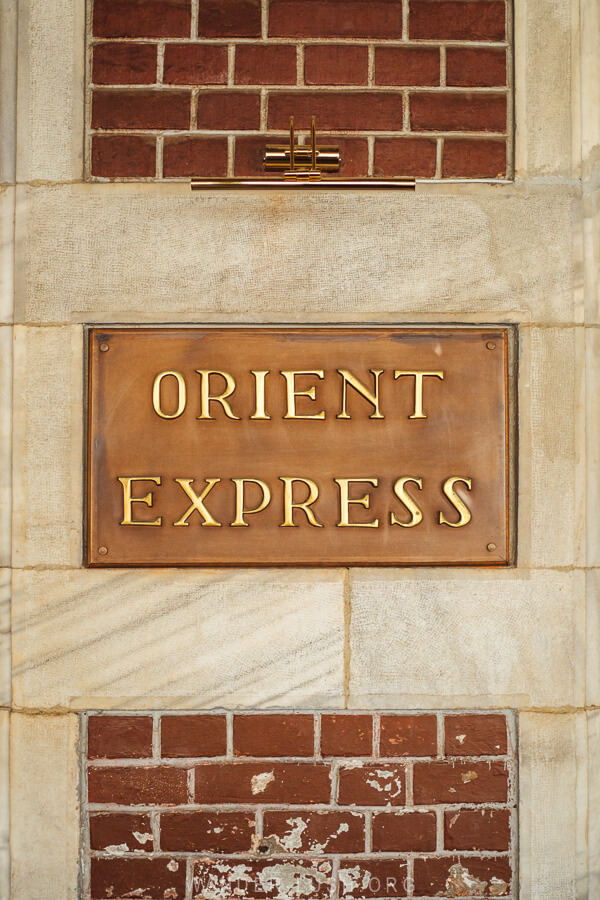

A second no-frills teahouse is located at the front of the station building. Here, groups of friends and workers on their coffee breaks sip cay seated on little wooden stools.
Have a good poke around the station: The light inside is phenomenal, and the rosy facade with its round stained-glass windows and bands of red brick is very pretty. Circle around to the front to see the old rolling stock parked in the garden.
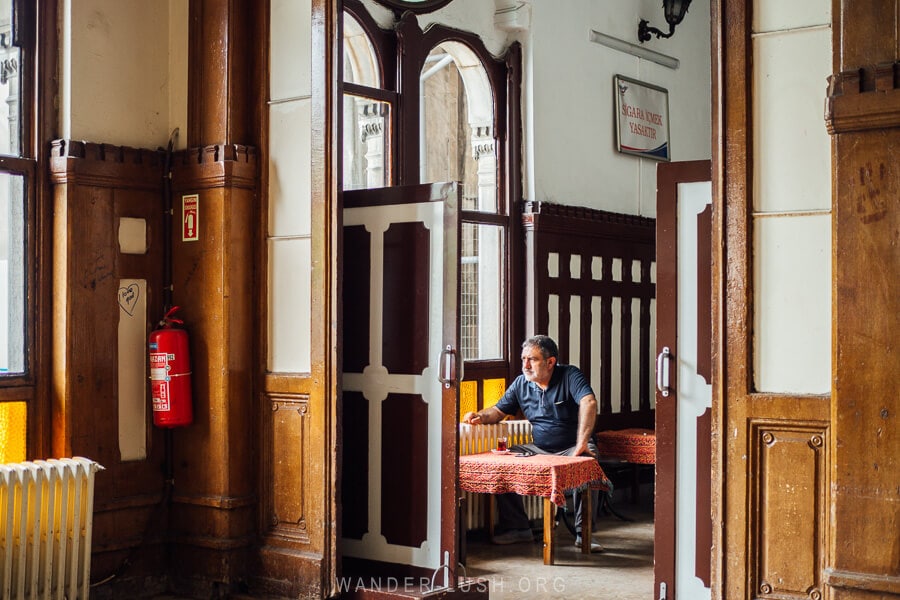
Normally Whirling Dervish ceremonies take place inside the vacuous waiting room on some nights of the week, but shows are currently on pause due to restoration work being done on the building. An alternative authentic Whirling Dervish show is coming up on Day 2 of this itinerary.
- Location: Ankara Cd.
Smell the tulips in Gulhane Park
The grassy lawns and manicured beds of Gulhane Park unroll from the eastern side of Sirkeci Train Station, serving as the perfect shortcut to reach Sultan Ahmed. Before plunging into one of Istanbul’s most frenetic areas, take a moment to smell the tulips.
This gorgeous green space is one of the locations for the annual Istanbul Tulip Festival. More than 2.5 million of the flowers – which come from Central Asia and were introduced to the West by way of the Ottoman Empire – bloom here every spring. At other times of year you can see the park plastered with daffodils and violas. Walking paths wind their way around monumental trees, and there are plenty of benches if you need to take five.
- Optional: Topkapi Saray lies on the other side of Gulhane Park. If you’re wanting to visit the 15th-century palace museum (open 10am-4pm Weds-Mon), this is the perfect time to do so. Bare in mind you need at least 2 hours to see all the massive complex has to offer – some people recommend 3-4 hours.
Hit the Istanbul must-sees: Hagia Sophia, the Grand Bazaar, the Basilica Cistern & the Blue Mosque
I realise this is a lot to pack into one afternoon/evening – but since you’re in the vicinity and Istanbul’s quartet of famous landmarks are all within walking distance of one another, you might as well try to fit in as much as you can.
The Hagia Sophia (open 24 hours; free), Basilica Cistern (open until 7pm daily; ticketed) and the Blue Mosque (open 24 hours; free) all require about 30-45 minutes each, provided you’re satisfied with a quick walk-through and the lines aren’t too long. I recommend visiting them in this order.
The Hagia Sophia needs no introduction. Just know that this 6th-century Byzantine wonder (which was the largest interior space in the world at the time of its completion) is every bit as impressive as the pictures suggest.
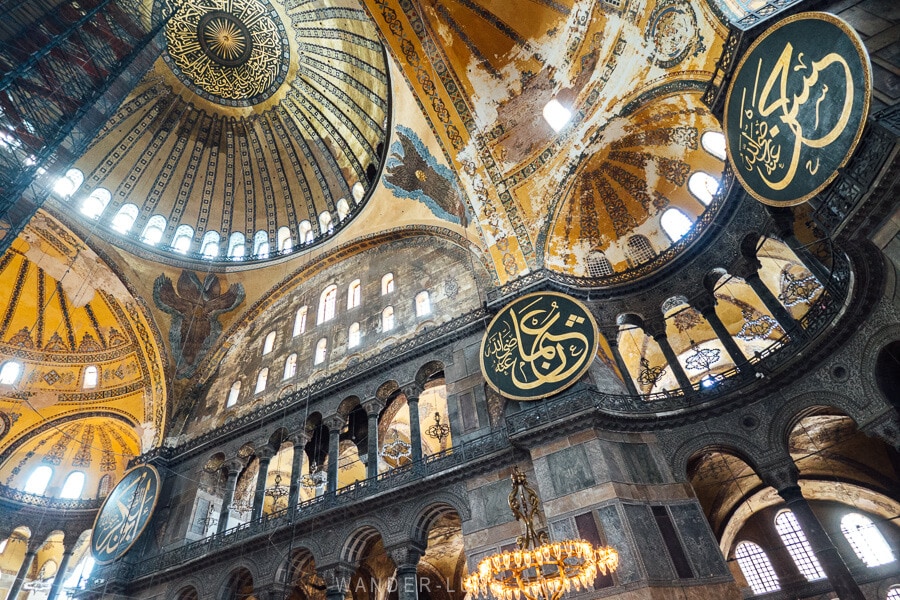
In 2020, the Hagia Sophia was reclassified as a mosque. That means doors close three times during the day for a period of about 90 minutes for prayers, and visitors are not permitted to enter during this period. Check times here, and try to time your visit for 30-40 minutes prior to closure to avoid long queues.
There are dozens of notable mosaics, gates and columns inside the Hagia Sophia. If you want an in-depth experience, a guided tour is absolutely essential. Most include skip-the-line access, which is a huge bonus.
Otherwise, a short counter-clockwise walk around the upper balcony and main floor is enough to satiate most people’s appetite. Remember to poke your camera out the narrow window on the mezzanine for a classic photo of Istanbul’s stacked domes and minarets.
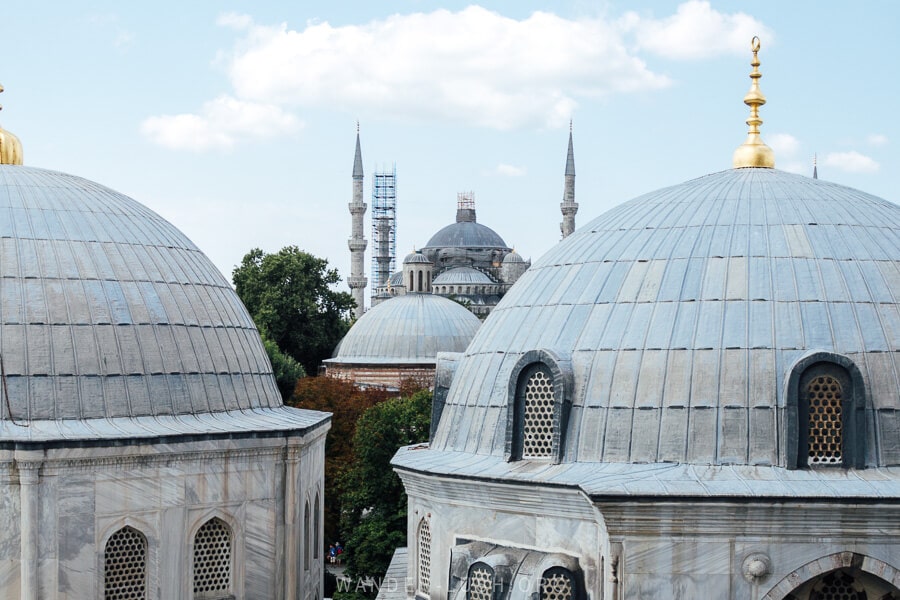
Just around the corner, the Basilica Cistern is the most well-known of the hundreds of underground water chambers that lurk beneath Istanbul’s streets. Constructed in the 6th century under Emperor Justinian I, it was the city’s biggest reservoir – 9,800-square-metres.
Elevated boardwalks lead visitors between the 336 decorative marble columns, some of which are engraved with ghostly figures. Dark and cool, it’s a welcome break from the heat on a warm day – just make sure you buy your tickets online in order to avoid the very long lines.
- Alternative option: The nearby Cistern of Theodosius (open until 6pm daily; ticketed) has a similar layout and is usually less busy than the Basilica Cistern. It also features a short light show that illuminates the columns and arches at hourly intervals.
Finally, stop in at the 1616-built Blue Mosque (Sultan Ahmet Camii). With its six spindly minarets and tiered domes, the anthropomorphic complex is colossal in size and visually spectacular when viewed up close.
Get a look at the mosque’s exterior from the nearby Sultan Ahmet Park, where avenues of palm trees and handsome light posts frame the central dome perfectly, then pop inside to see the courtyard and exuberant main prayer hall. Like the Hagia Sophia, this is an active mosque, thus entry is only permitted outside of prayer times.
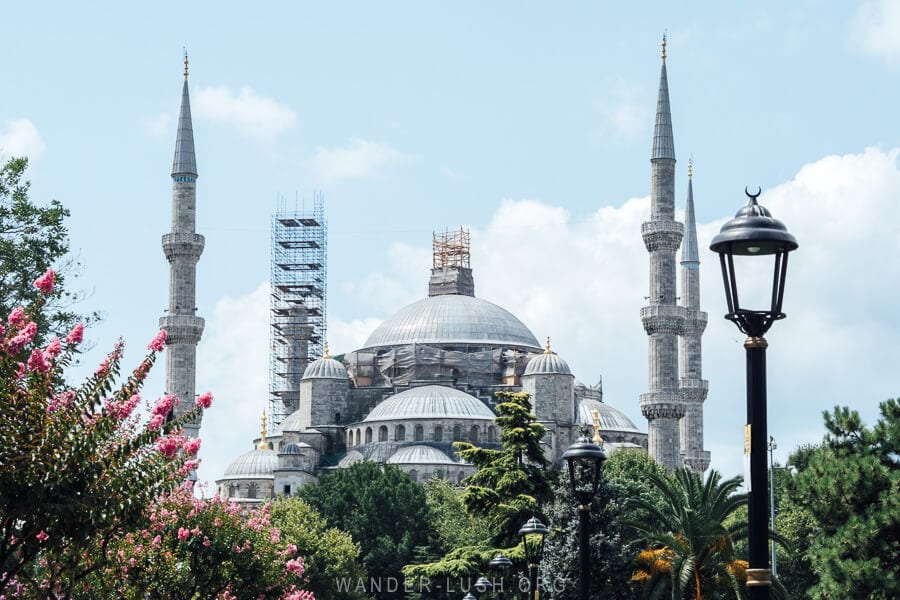
- Optional: If you have enough time for a peek inside the Grand Bazaar (open daily until 6pm), jump on the T1 tram and ride 10 minutes to reach the entrance. I know that the Kapali Carsi is an Istanbul icon, but I personally prefer the Spice Bazaar (Egyptian Bazaar), which features on Day 2 of this Istanbul Itinerary. A quick walk through the Grand Bazaar for a glance at the painted ceilings was plenty enough for me.
Watch the sunset from Galata Bridge
Finish your day where you started, back in Galata. The Galata Bridge is Istanbul’s most popular sunset spot, and for good reason: The views are immaculate, particularly as you look out towards the Golden Horn.
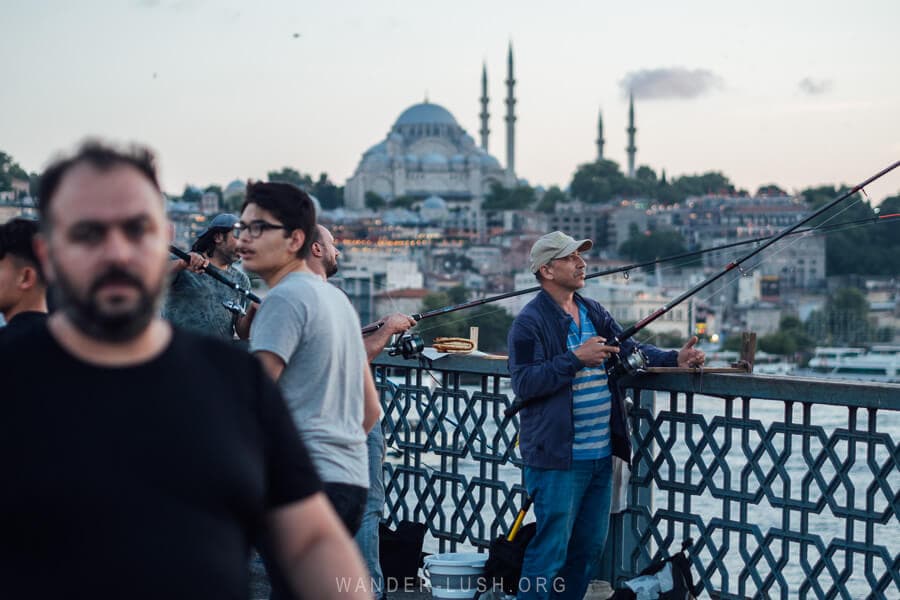
I recommend finding a spot to stand on the western side of the bridge, above the area where the Karakoy ferry docks. Aim to arrive about an hour before sunset for the best light.
For the perfect photo, wait patiently for the garbage truck to come down the street and dump its load in the bins near the ferry terminal – this sends the seagulls into a frenzy, and they fill the skies with their spinning and diving for a good 15 minutes.
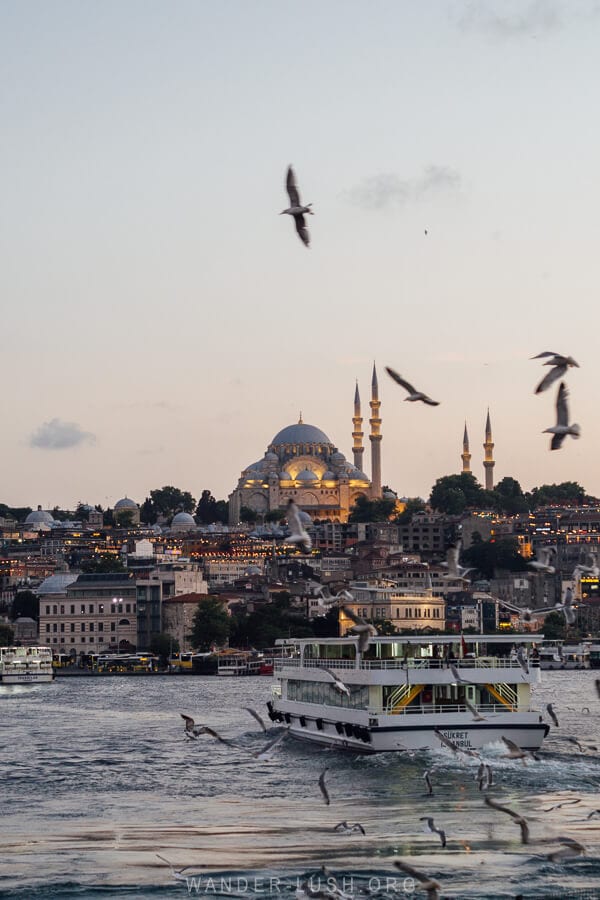


Eager anglers line the bridge and provide excellent entertainment while you’re waiting for the sun to drop. When we visited, a particularly friendly fisherman even gave us a whirl on his rod!
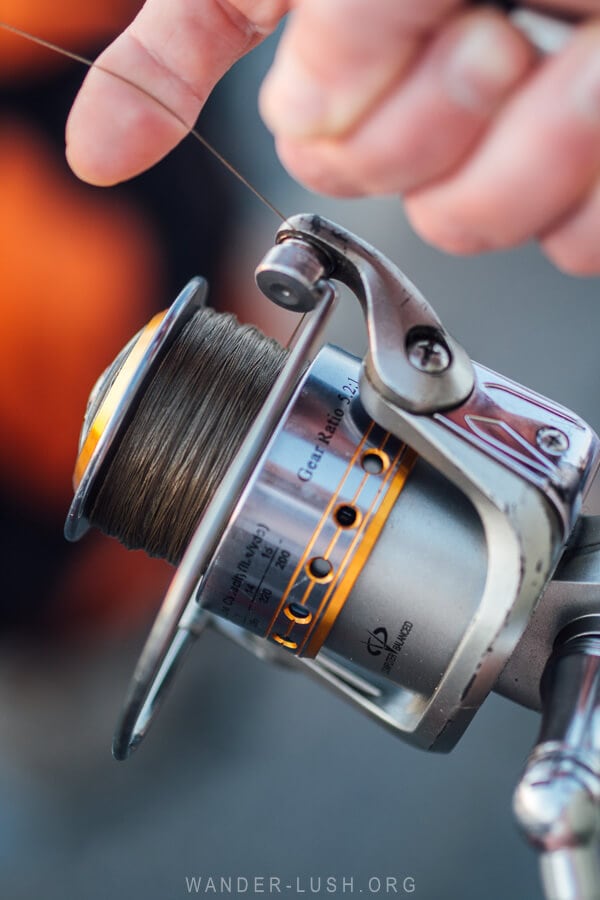

Day 2: Colours of Istanbul – Fener, Balat, Ayakapi, the Spice Bazaar & Fatih
Still staying central, Day 2 takes you to some of Istanbul’s most colourful corners.
I highly recommend arriving in Fener by ferry for a wonderful view of the Private Fener Greek High School towering over the little terminal building as you pull in.
Eat a traditional kahvalti Turkish breakfast at Velvet Cafe Balat
It’s hard to go wrong with breakfast in Istanbul. But I think you’ll agree that the best way to start the day is with a kahvalti traditional Turkish breakfast – which dare I say is a must-do for all visitors.
This is one thing you cannot rush. Kahvalti should be enjoyed at a leisurely pace over the course of two pots of tea (equivalent to 90 minutes or more), which is why I recommend saving it for your second day.
Velvet Cafe Balat serves an epic Turkish breakfast with house-made condiments (the citrus butter and the tahini are both worth writing home about) and picture-perfect presentation. The price is very reasonable for two people, and portions are generous but not over the top as they are at some other venues. The outdoor courtyard here is very charming, with its mismatched chairs and lacy tablecloths.
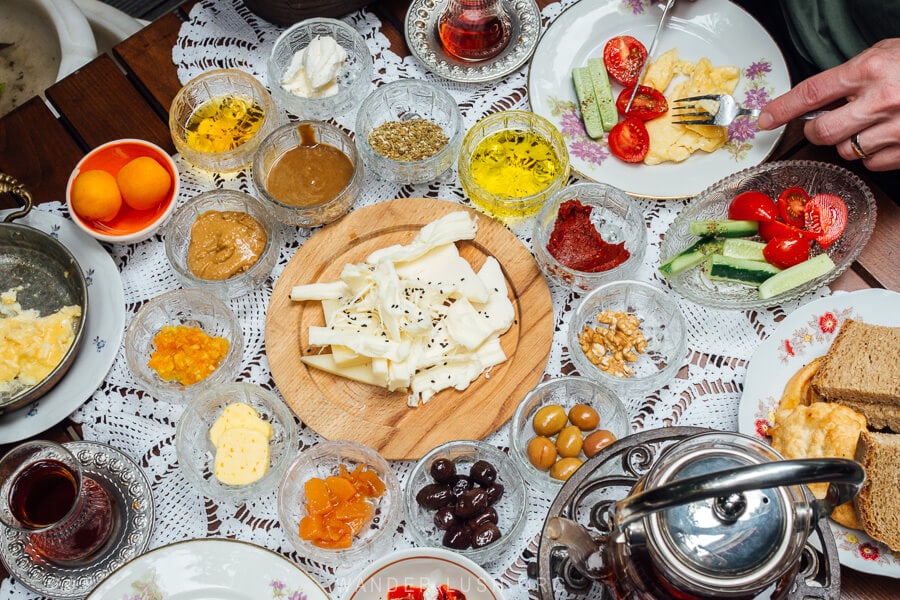
- Location: Cimen Sk. 8a
- Opening hours: From 9.30am Tues-Sat & 10am Sun (closed Mondays)
Photograph the colourful houses & antique shops in Balat & Fener
After fueling up, it’s time to explore one of Istanbul’s hottest neighbourhoods, Balat/Fener. This duo of cute districts with Jewish and Greek roots respectively are both known for their antique shops, vertiginous laneways, and of course the multitude of colourful painted houses.

The prettiest facades are clustered around Balat’s Kiremit and Merdivenli streets. You’ll likely find the streets surrounding the famous ‘Coloured Houses of Balat’ (Balat Renkli Evler) swarming with people, even in the early morning.
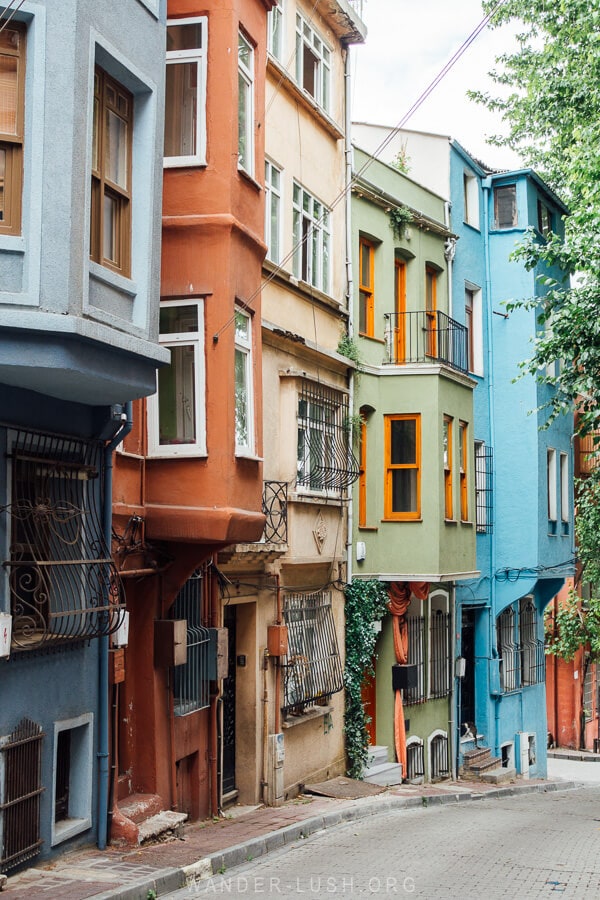

In my experience, the backstreets around the Fener High School are a lot quieter and just as photogenic, while the lower part of the neighbourhood near the ferry terminal is also lovely, with its ramshackle bric-a-brac shops and vendors pushing treasure-laden carts up and down the cobbles.
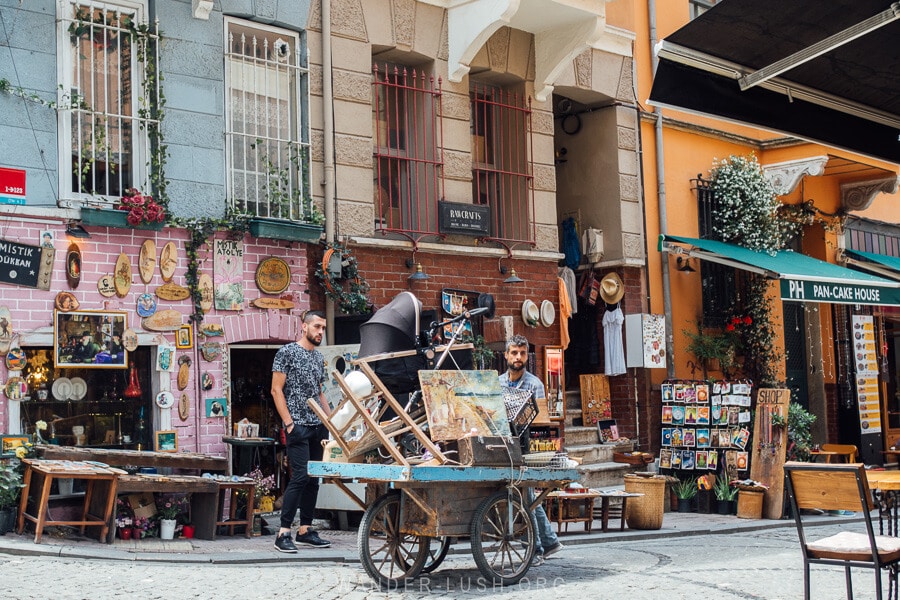
Take a detour to Kariye Mosque (Chora Church)
If you have it in you, challenge yourself to the 15-minute uphill jaunt from Balat to Edirnekapi to visit the Kariye Mosque, AKA Chora Church (open from 9am daily; free).
Much like the Hagia Sophia, this building started life in the 4th century as a church (Greek Orthodox this time) before being converted into a museum. Today it is an active mosque. Outside of prayer times, visitors can enter to see the fine Byzantine frescoes and iconographic paintings, which defied all the odds to survive almost completely intact.
It’s one of the oldest buildings in the city, and considered by many to be more important than even the Hagia Sophia in terms of its historical and cultural value.
Note: The Chora Church is currently closed for renovations and is scheduled to reopen in 2023.
- Location: Kariye Cami Sk. 18
Saint George’s Cathedral & Ecumenical Patriarchate
Closer to the painted houses, Saint George’s Cathedral & Ecumenical Patriarchate is another important Christian landmark in Istanbul. Belonging to the Eastern Orthodox Church, it is the seat of the Ecumenical Patriarchate of Constantinople, whom 300 million worshippers hold dear as their spiritual leader.
Representing 1,700 years of Orthodox Christian history, it is an essential piece of the puzzle that makes Istanbul what it is.
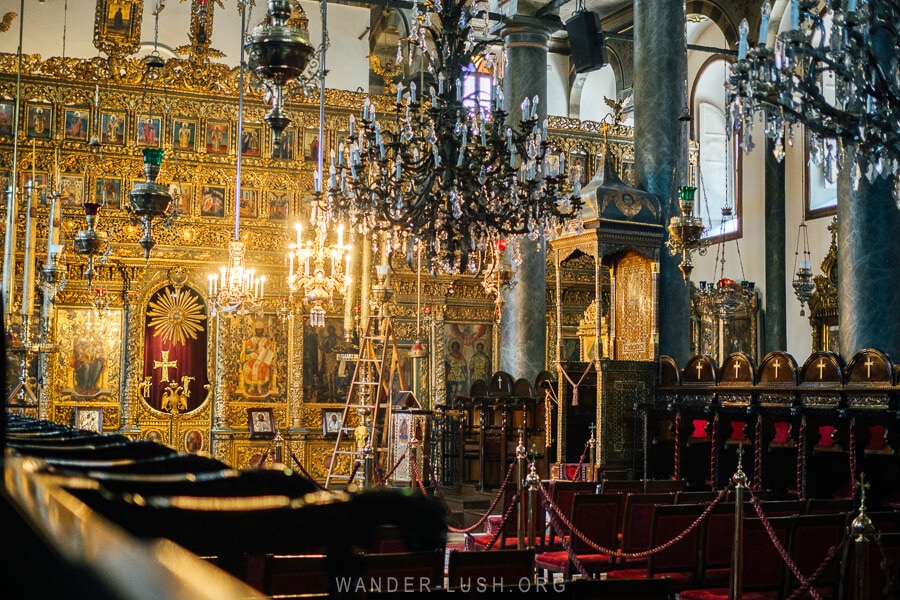
The complex consists of several buildings gathered around a courtyard. The Church of St. George has a stunning interior with an opulent wooden iconostasis, a walnut and ivory candle stand, and a throne that resembles a twisted vine.
Services are held every Sunday morning. Entry is free, but you must pass through a security screening.
- Location: Dr. Sadık Ahmet Cd. 19
- Opening hours: 8am-5pm daily
Walk the waterfront Balat Sahil Park to Ayakapi
Balat Sahil Park follows the waterfront from the Fener ferry terminal to Ayakapi. There is zero shade and lots of sunflower seed shells to contend with! But nonetheless, it’s a pleasant way to get from A to B with water views to boot.
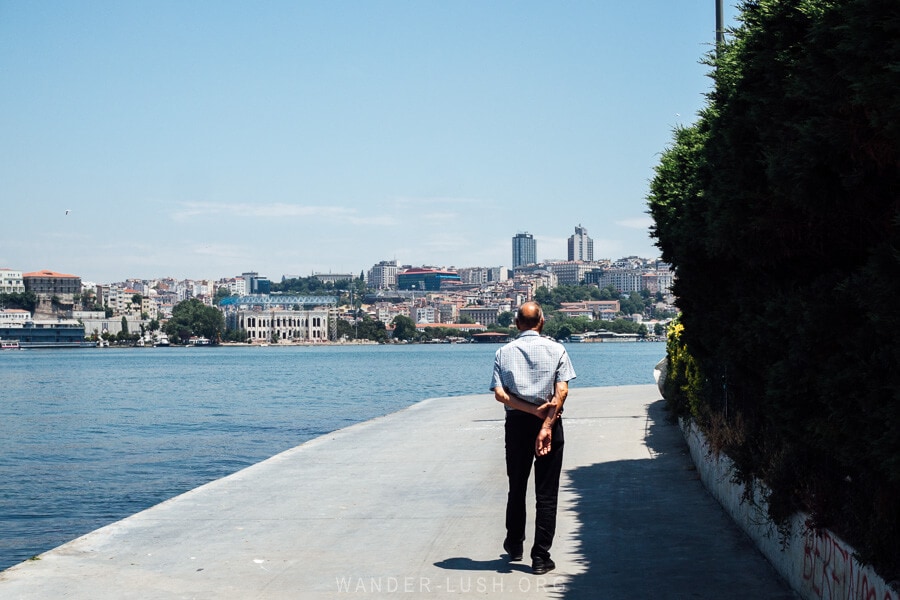
Cross inland to Ayakapi and stop for a pick-me-up at Hamur Isi Cafe & Kahve & Kahvalti (open from 7.30am Mon-Sat & 10am Sun). Both Turkish and Italian-style coffees are on the menu along with delicious homemade cookies with a soft halva centre.
There are some lovely buildings in the Ayakapi neighbourhood, including this pretty pink number.
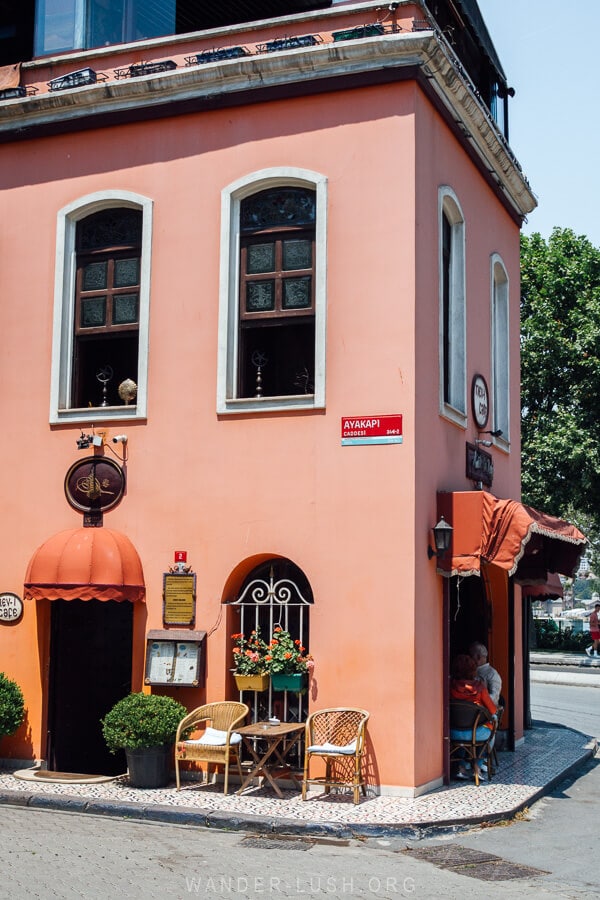

Pop into Fatih Mosque
From Ayakapi, it’s a rising but short dash to reach Fatih Mosque, which proudly towers atop one of Istanbul’s hills. This is my favourite mosque in the city.
Crane your neck to examine the ornate plasterwork above the entrance portal before making your way inside. From the second-floor women’s mezzanine you get an incredible bird’s eye view over the carpeted prayer floor. The ablutions fountain in the central courtyard, surrounded by soaring arches, is just perfect.
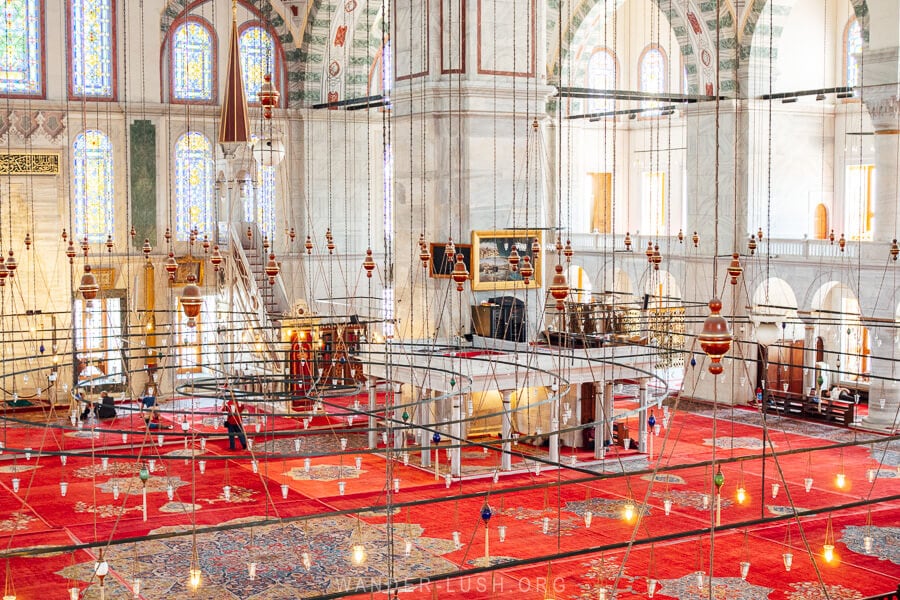

Dated 1470 and named after Sultan Mehmed the Conqueror, the mosque is connected to the Sahn-i-Seman Medressa, an important centre of astronomy, mathematics and theology during the Sultan’s era.
Browse the Spice Bazaar (Egyptian Bazaar)
Grab an easy lunch near the mosque before boarding a local bus to take you east towards Eminonu. Sit on the left-hand side for a look at the impressive Aqueduct of Valens as you pass by.
In my opinion, the Spice Bazaar or Egyptian Bazaar, Misir Carsisi, offers a much more interesting experience for window shopper’s compared with the Grand Bazaar. It’s just as crowded and frantic, but I personally preferred searching through the mountains of spices, piles of soaps and heaps of herbal teas versus browsing row upon row of same-same souvenirs on offer at the Grand Bazaar.
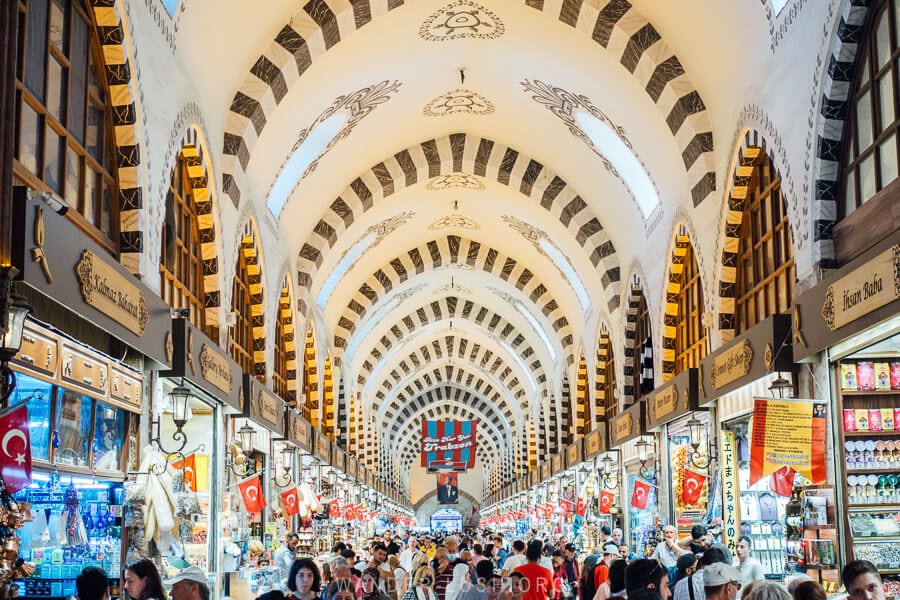
Save your shopping for the local market featured on Day 3.
- Location: Erzak Ambari Sok. 92
- Opening hours: From 8am daily
Experience an authentic Whirling Dervishes ceremony in Fatih
Once a week, Fatih’s Sehremini neighbourhood hosts a very special Mevlevi Sema Whirling Dervishes ceremony. If you happen to be visiting Istanbul on a Thursday, be sure to plan your day around this experience.
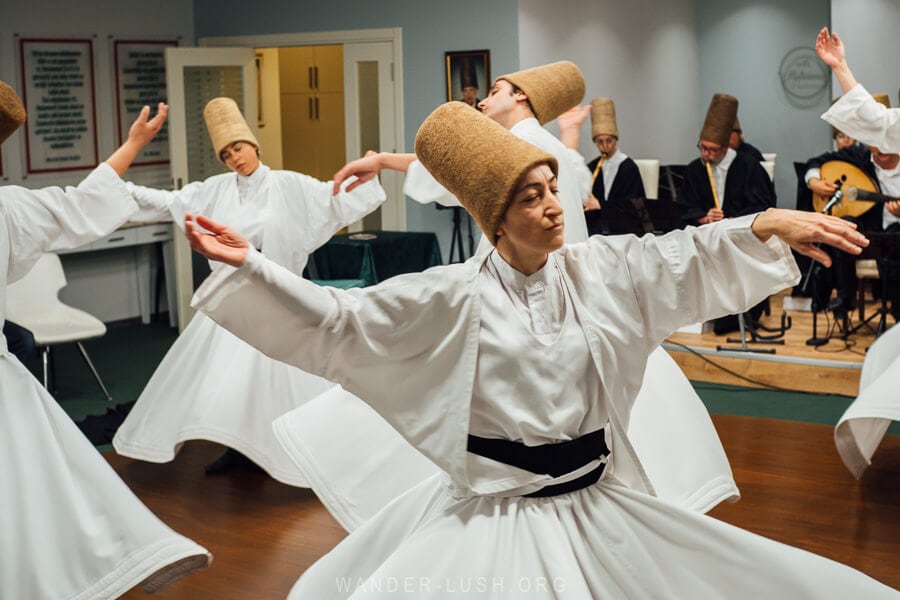
Hosted by EMAV, the Foundation of Universal Lovers of Mevlana, this is a much more intimate and authentic Sema experience compared to the touristy shows on offer. (I have attended both.)
Find all the details, including how to buy tickets, in my guide to seeing the Whirling Dervishes in Istanbul.
Day 3: The Asian Side – Kadikoy, Kuzguncuk & Uskudar
After two days in Europe, it’s time to cross over to Asia and uncover some of the contrasts and parallels between Istanbul’s two opposing sides. You will probably find they have more in common than not, however there are some observable differences.
Cross from Europe to Asia by ferry
Assuming you’re staying on the European side of Istanbul as most people do, start your morning with a ferry crossing over the Bosphorus. This is a quintessential Istanbul experience, especially when you’re following this particular route that goes from west to east.
Ferries to Kadikoy depart from Karakoy and from Besiktas. The latter route is particularly beautiful as it takes you directly past the Dolmabahce Mosque.

On board the boat, embrace the ins and outs of ferry culture – order a cup of tea from a roving vendor, and look out for the little everyday vignettes that unfold onboard.
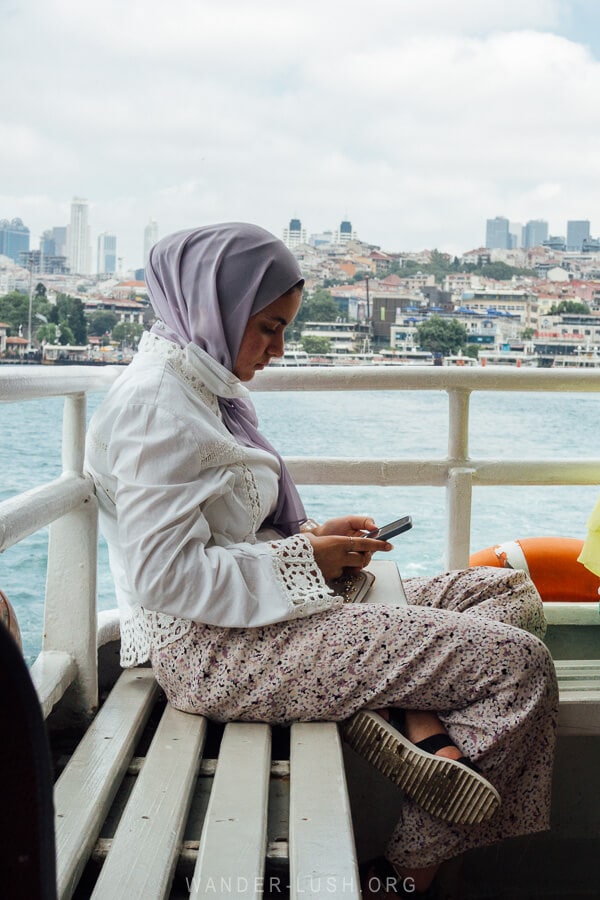

I always feel that ferry trips in Istanbul are far too short! When you arrive at Kadikoy pier on the Anatolian side, you’ve officially crossed from Europe to Asia.
Explore cosmopolitan Kadikoy
In a way, Kadikoy is a slightly more subdued version of Karakoy. It has its own historic tram line and pedestrian street, Bahariye Caddesi. Its narrow rib-like laneways are similarly clad with cafes and cute shops, but Kadikoy has a different, more local or maybe laid-back feel – especially early on a Sunday morning, which is when I visited.
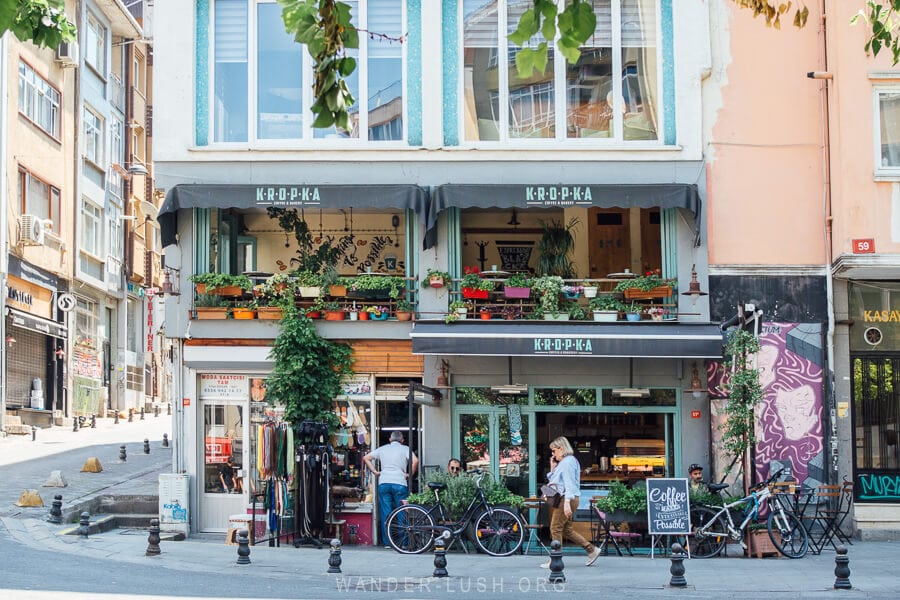

I found parts of Kadikoy quite sparse, especially the peninsular area (though the streets around the Baris Manco Museum are quite interesting).


I suggest sticking to the roads around the ferry pier, perhaps making a quick detour to rummage the Akmar Kadikoy Sahaf bookshops and walk down Moda Caddesi, where there are fun gift boutiques such as Cicekisleri, specialty cafes, and bubble tea shops.
Roam the boisterous Kadikoy Market
The streets closer to the pier that radiate out from Kadikoy Square are a jumble of markets, delicatessens and spice shops. While you might visit the Grand Bazaar and the Spice Market for the architecture and history, this is the sort of market you come to for the atmosphere and the shopping.

Kadikoy Market still very much feels like the domain of locals. Amongst stalls overloaded with glossy olives and stacks of vine leaves, you can find some great take-me-home items, including jars of local honey, packets of green tea from Rize, hand-whittled wooden spoons and kitchen accessories, packaged spices (be sure to pick up some Kurdish pepper, isot), and bottles of Turkish-style hot sauce.
You’ll notice there are lots of tursulari pickle shops in this area, the most celebrated being Ozcan Famous Pickle. I guess the name says it all – but we were completely oblivious to the owner’s celebrity status, drawn in by the particularly fetching pickle display instead!
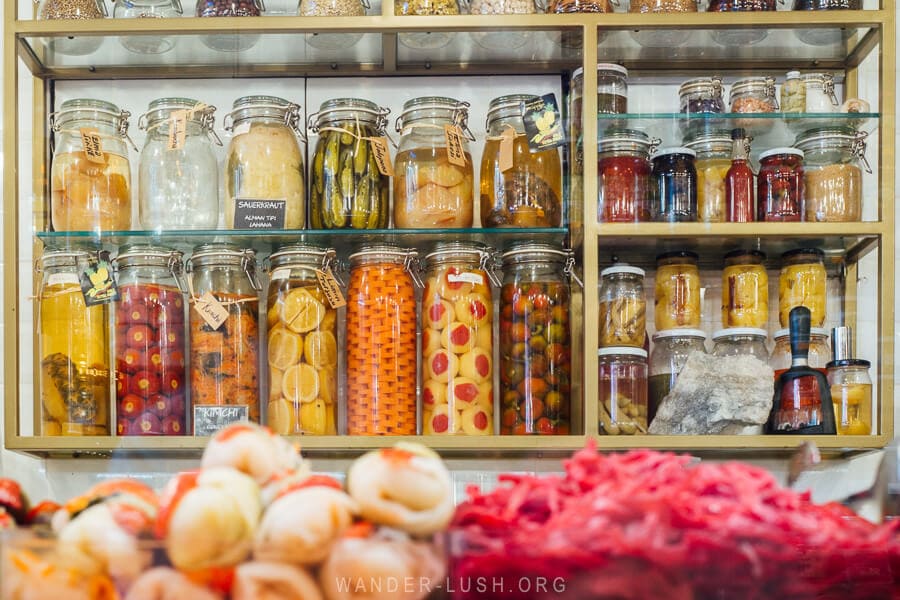
We walked out with some spices (which staff very kindly wrapped for us to ensure they would survive the plane ride home), but we skipped on a glass of pickle juice (tursu suyu) from the dispenser at the back.
Stop for an early meze lunch on Gunesli Bahce Street
If you’re feeling peckish by this point, the area around Kadikoy ferry pier is a top place to stop for a laid-back lunch. Seafood is the order of the day at the many meyhane meze bars that line the pedestrianised Gunesli Bahce Street.
On a mission to find Istanbul’s best fried calamari, we weighed up our options before opting to eat at the quaint blue-and-white-tableclothed Hamsi Pub (open from 8am daily), a historic taverna that started out in the market in 1979 and was the first fish restaurant in Kadikoy to start serving alcohol. The food was very good (especially the calamari), as were the cold beers.
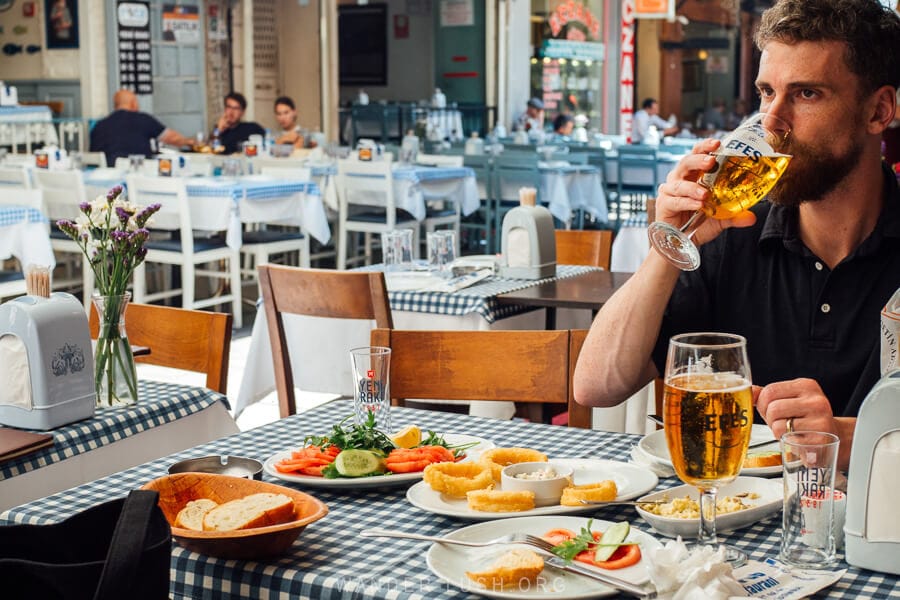
Stroll the Uskudar Coast Walkway
After lunch, hop back on the ferry or find a bus to travel up the coast to Uskudar. A cultural hub since Ottoman times, Uskudar was once a stop on the historic Silk Road. This is the place where traders would buy their saddles, horses and supplies before waving goodbye to Europe and pressing on into Asia.
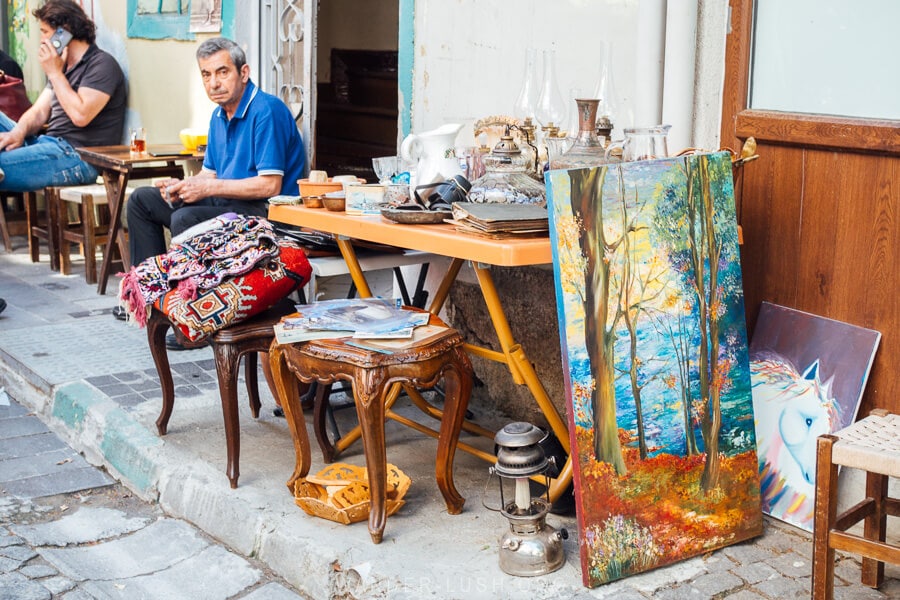
In many ways, Uskudar feels like a separate city caught within the boundaries of Istanbul. Side streets reveal little antique shops and in garages, friends strum baglamas, singing folk tunes about old Uskudar.
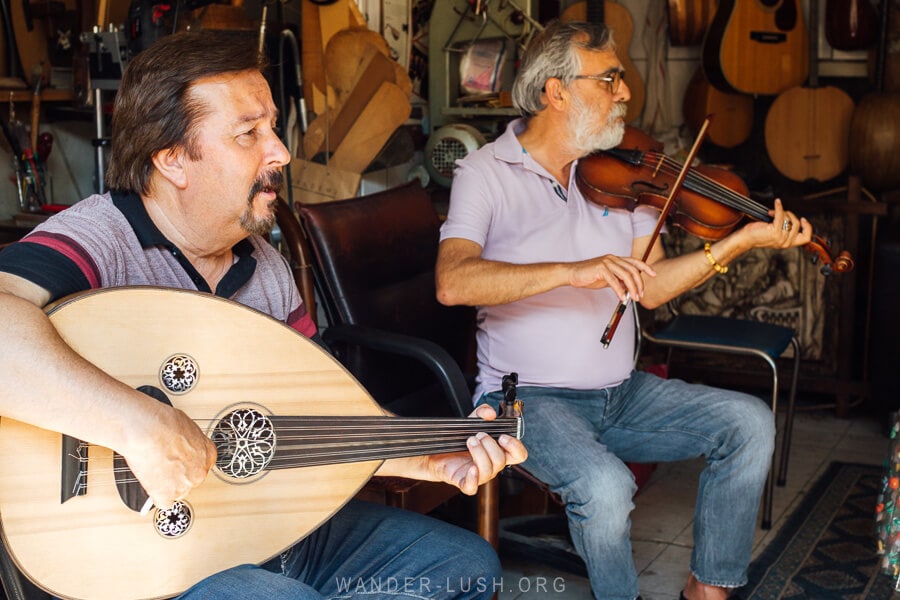
Uskudar also happens to have one of the loveliest slices of waterfront real estate imaginable, with a long promenade that swells into the Bosphorus. The Uskudar Coast Walkway directly faces onto Karakoy, meaning you get impeccable views of the Blue Mosque, Hagia Sophia and Topkapi Palace across the water – if you’re brave enough to dodge the long fishing lines that sweep and swoop across the promenade, that is.
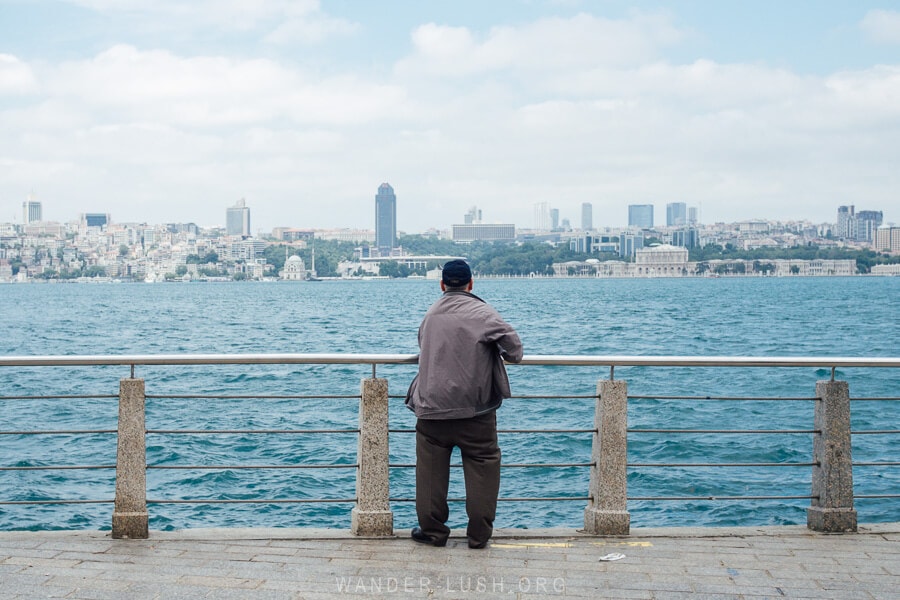
If you traverse the curve of the coastline, you’ll get a perfect outlook over the Maiden’s Tower (Kiz Kulesi), a Byzantine-era lighthouse/toll point that now houses a restaurant. Unfortunately it was closed and concealed with scaffolding at the time of our visit.
Walking north towards the ferry terminal, you’ll pass the glittering Shemsi Pasha Mosque that sits like a siren on the seaside. Duck inland to visit Nevmekan Sahil (open from 10am daily), a book cafe, art centre and library that puts a modern spin on Turkey’s tea-house traditions.
Grab a coffee and soak up the scholarly vibes or just find a spare seat and take a quiet moment to yourself. It’s worth going inside just to see the interior: Designed by Turkish architect Hilmi Senalp, the building was formerly a wedding venue and features a stunning central atrium with a glass roof in the shape of an unfolding flower.
Photograph the houses in Kuzguncuk & get some fresh air in the Bostani
Uskudar is a huge area with several discrete neighbourhoods, including the historic Kuzguncuk (‘Little Raven’), which lies a short walk north from the ferry terminal.
All plane trees and cobblestones, it’s the epitome of a peaceful, idyllic residential area. (Although that has changed somewhat in recent years after a popular TV series called Perihan Abla was filmed here and it became a pilgrimage site for enthusiastic sit-com fans.)
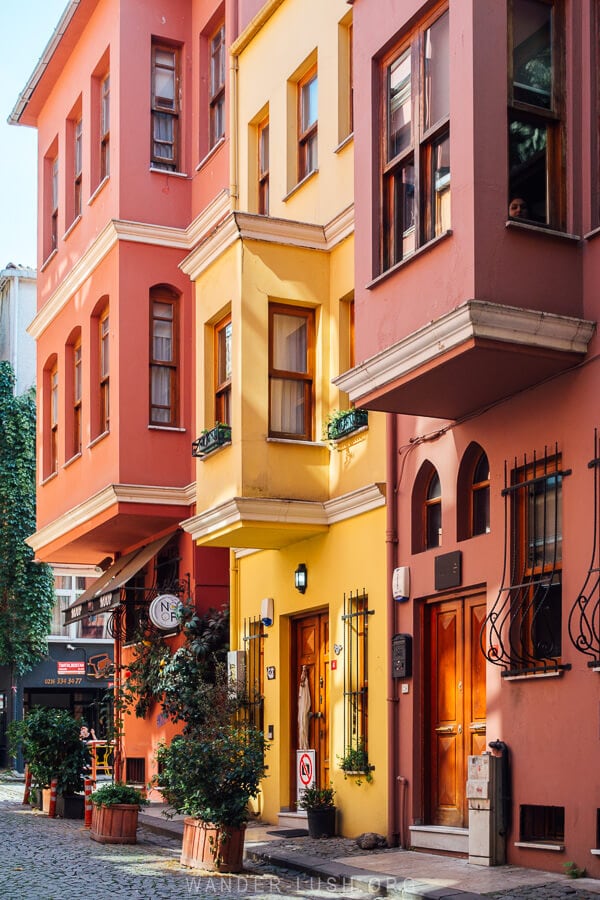

There are a couple of things worth seeing in this area, including Kuzguncuk evleri, a set of heritage wooden chardak houses painted in rich gem tones, and the Kuzguncuk Bostani, an urban vegetable garden hemmed by a row of beautifully balconied cottages – Istanbul’s own Painted Ladies, if you will!
Bostan market gardens like this one once flourished all over Istanbul and furnished the city with the majority of its fresh food. Today, this is one of only a handful that have survived, thanks in no small part to persistent protests to prevent developers from building on the land. Pathways run between the raised vegetable beds, which are lovingly tended by local homeowners.

Catch the sunset from Camlica Hill (optional)
Kuzguncuk is striking distance from one of Istanbul’s most prestigious sunset spots, so if you have time, take a 60-minute bus or taxi ride up to the crest of Camlica Hill for sweeping views of Istanbul from afar.
Otherwise, take your time meandering around Kuzguncuk before settling down to dinner.
Dinner at Hatice Anne Ev Yemekleri
Located on the top floor of an apartment house in Kuzguncuk, Hatice Anne Ev Yemekleri promises one of Istanbul’s most intimate dining experiences. The super-snug dining room and open kitchen looks and feels like a private home. Grab a stool at the raised bench along the front window that overlooks the waterfront.
Home-cooked, hearty food prepared according to family recipes (the restaurant is named after the chef-owner’s mother) highlights seasonal, market-fresh produce – possibly gathered from the bostan around the corner. Must-trys include the vegetarian rice sarma (stuffed vine leaves), which are rolled as thinly as possible, as tradition dictates, and the baklali enginar, artichokes with broad beans.
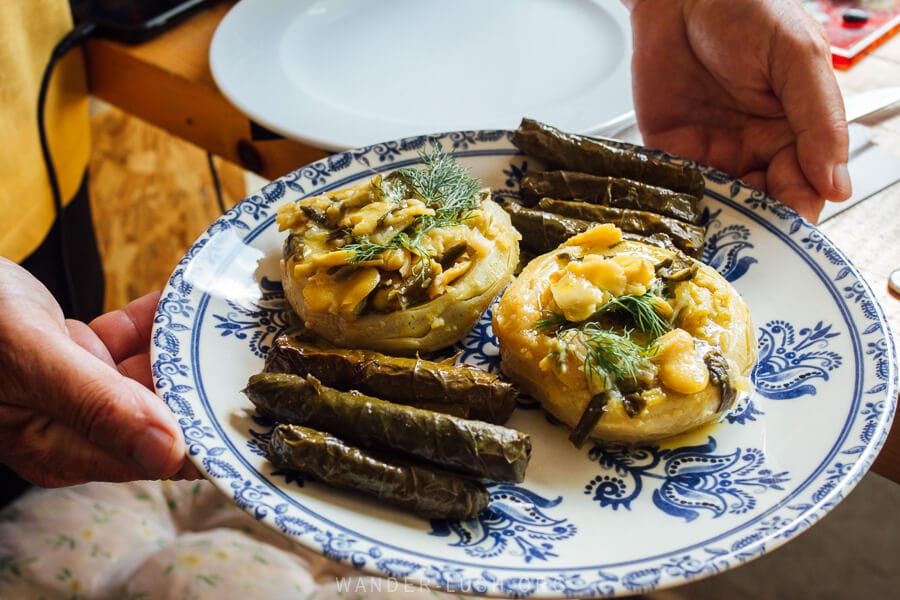
Seating is limited, so reservations are strongly recommended.
- Location: Kuzguncuk Carsi Cd. 4
- Opening hours: Until 9.30pm daily
Day 4: Local Neighbourhoods – Besiktas, Arnavutkoy, Cihangir & Cukurcuma
Some of my favourite places in Istanbul are the small neighbourhoods filled with unexpected gems.
Kuzguncuk was just a small taste – Day 4 is completely dedicated to exploring the city’s districts, including lesser-known Arnavutkoy and the trendy hoods of Cihangir and Cukurcuma.
Eat bal kaymak on Besiktas Breakfast Street
Celebi Oglu, Besiktas ‘Breakfast Street’, is an early morning mecca. Dozens of sidewalk cafes and hole-in-the-wall restaurants compete for business from bleary eyed Istanbulites and tourists alike.
Treat yourself to another full spread breakfast, or pick and choose a couple of items to share a-la-carte. My go-to for breakfast in Istanbul is bal kaymak, a rich and velvety clotted cream made from water buffalo milk served swimming in honey. The combination of textures, temperatures and sweet and buttery flavours is mind-blowing. Pillowy soft somun breakfast bread is delicious, but let’s be honest, it’s just a vehicle for the bal kaymak and a means to an end!
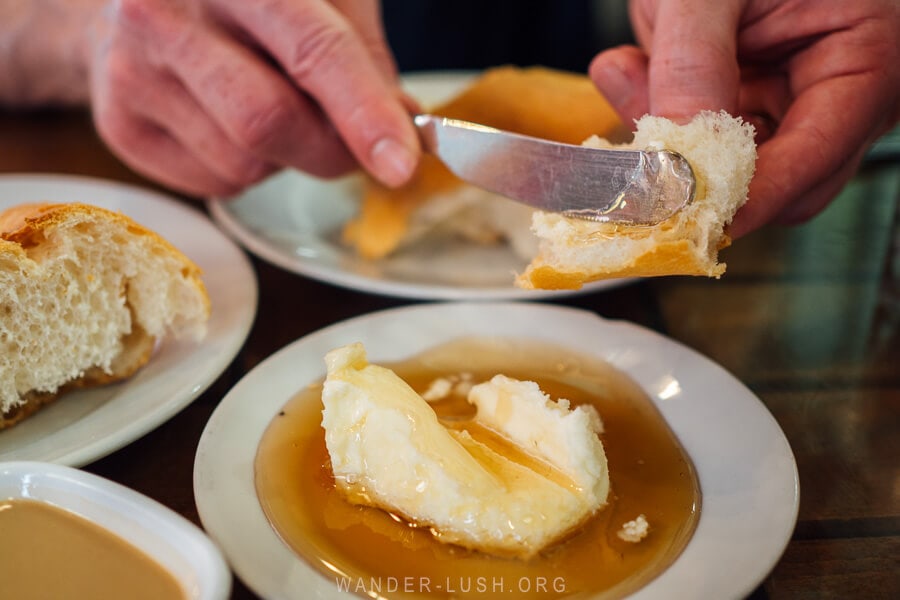
The bal kaymak at Cakmak Kahvalti Salonu (open from 7am daily) is so good, I came back two days in a row to order it again. They also do a nice menemen scrambled eggs with tomato and a range of other small plates.
Pass by the Sinan Pasha Mosque & Tomb of Barbarossa
The Ottoman Empire’s maritime achievements are proudly displayed all over Besiktas. The Naval Museum (from 11am Tues-Sun) is worth a stop if you have a particular interest in the region’s seafaring history.
A short walk from Breakfast Street, the Sinan Pasha Mosque was built in 1555 for Grand Admiral Sinan Pasha. It is particularly interesting because it’s framed by an expansive madrasa school and boarding house (the proliferation of small chimneys emerging from the roof reveals the building’s purpose: each room had its own fireplace).
The mosque’s painted interior is particularly detailed, and the central courtyard features a fountain fashioned from a recycled Roman sarcophagus. Interestingly, the main mosque in Prizren, Kosovo is dedicated to the same admiral and carries the same name.
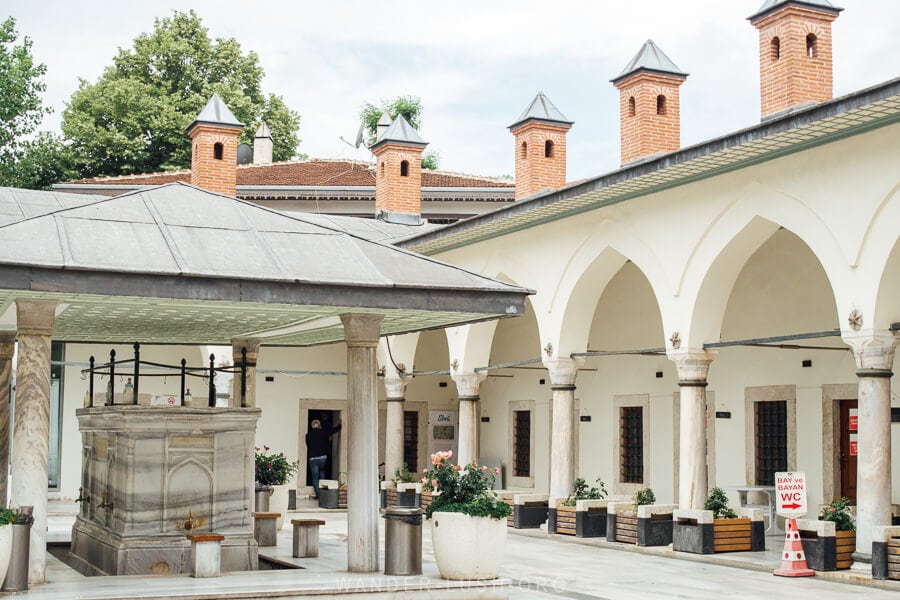
Across the street, Hayreddin Barbarossa Tomb is the final resting place of ‘Redbeard’, the legendary Ottoman admiral whose escapades inspired a spate of film characters.
- Optional: Dolmabahce Palace (open from 9am Tues-Sun; ticketed) – the former administrative centre of the Ottoman Empire – is located in this area. A tour of the grounds and halls, including the clock tower, gardens and the gorgeous Dolmabahce Mosque, harem and painting museum, takes the better part of 4 hours.
Admire the Ottoman-era mansions in Arnavutkoy
When you’re ready to leave Besiktas, jump a city bus to travel up the coast to Arnavutkoy (‘Albanian Village’). This charming district that hugs the coast is my favourite place in Istanbul.
An hour or two is all you need to wander petite Anavutkoy. Admire the majestic Ottoman-era waterside residences – tall and slender houses built in the late 19th century and infused with Art Nouveau elements – and get lost down the steep backstreets, where colourful staircases and stunning viewpoints await.
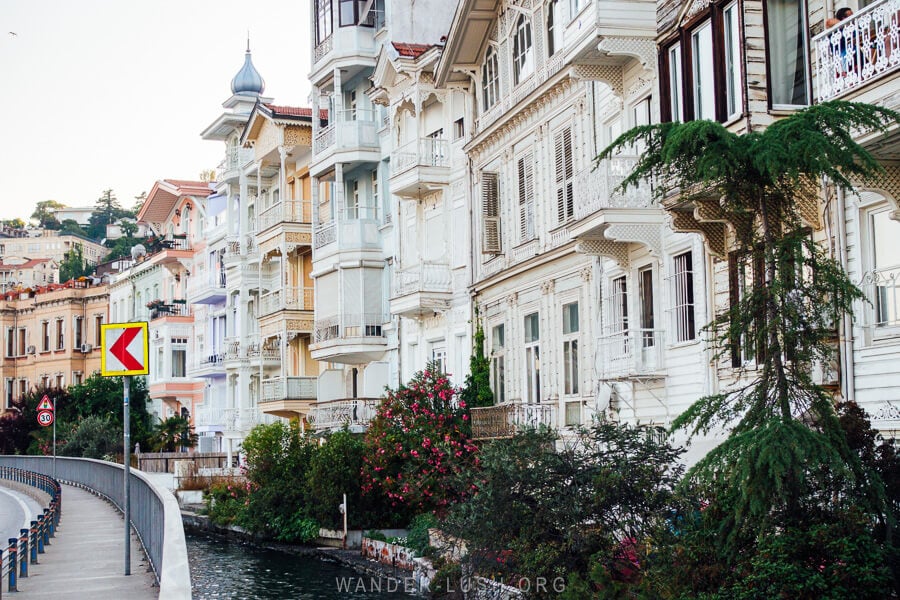
See my full guide to Arnavutkoy district for more photos and tips.
Grab an easy lunch at Yali Arnavutkoy or an afternoon snack at Weber’s Arnavutkoy before heading back down the coast by bus.
Spend the afternoon in Cihangir & Cukurcuma
The twin micro-districts of Cihangir and Cukurcuma, both in Beyoglu, are definitely more ‘discovered’ than Arnavutkoy, but they are charming nonetheless.
Bohemian Cihangir (pegged as ‘Istanbul’s Soho’) is a favourite stomping ground for writers and actors (and more recently, expats), and is dominated by fashionable cafes, artisanal grocers and artists’ spaces.
If Cihangir hints at Soho, then Cukurcuma (‘Friday Valley’) is the Le Marais of Istanbul. It has a very European feel, with antique shops and sidewalk bistros. This area was made famous by Orhan Pamuk’s 2008 novel The Museum of Innocence – part of the plot unfolds on the streets of Cukurcuma.
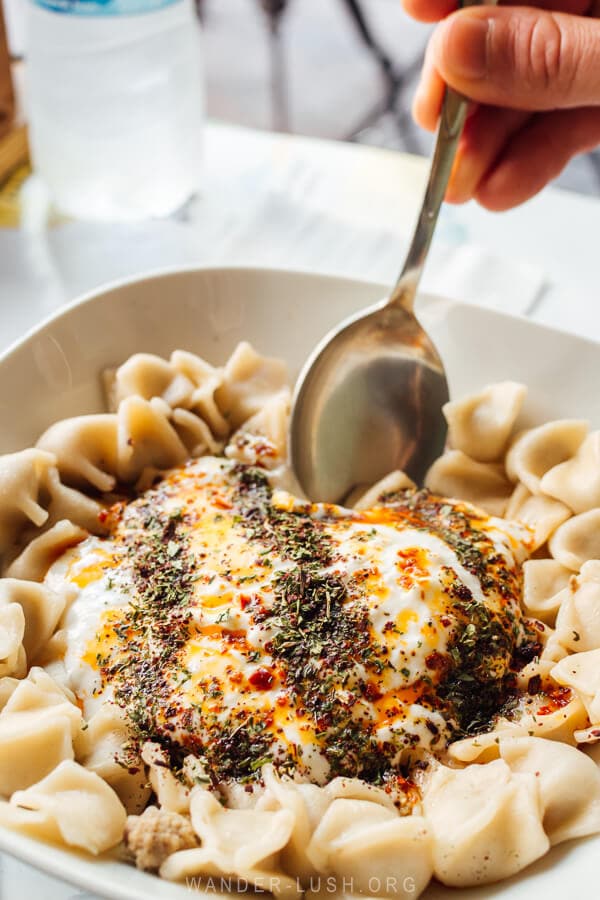

Things to see and do in this area include:
- The Museum of Innocence, a quirky house-museum inspired by the novel
- Cihangir Park stairs, a fabulous lookout point with Bosphorus views
- Norm Coffee, one of the district’s best-regarded cafes
- Doyum Cafe Manti, one of my favourite restaurants in Istanbul and the perfect spot for a dumpling dinner (pictured above)
Indulge in a traditional Turkish bath at Aga Hamami
If you have less time in Istanbul, you’ll definitely want to bump this up to Day 1 because it’s a must-do. Otherwise, save your hammam experience for your final night.
The tradition of the Turkish baths culminates with a kese, a peel-slash-soapy-massage staged on a stone slab that’s designed to free you from a layer or two of dead skin and reinvigorate body and soul.
The bath experience is very easy for outsiders to navigate – tourist-facing bathhouses function like well-oiled machines. Some of the fancier hammams offer different massage treatments, but unlimited time in the communal (usually segregated) bathroom amongst the marble fountains is always included in the price.
Constructed in 1454 as a private bath for Mehmed the Conqueror, Aga Hamami describes itself as the oldest hammam in Istanbul. I had my first ever Istanbul bath experience here, and it was divine.
The tagline ‘We offer you history, not luxury’, is a bit self-deprecating – I actually found it pretty opulent, especially compared to the Tbilisi sulfur baths! Aga is conveniently located close to Taksim Square and offers four well-priced packages, including a basic peel and foam bath for 700 TRY.
Advance reservations are essential.
- Location: Turnacibasi Cd. 48
- Opening hours: Until 10pm daily
- Alternative option: For something more upscale, Kilic Ali Pasa Hamam in nearby Karakoy is more grand in both its aesthetics and its treatment options. Attached to the mosque of the same name, it was built in 1578-1583 and features soaring brick arches and a fountain. Prices are only slightly dearer compared with Aga Hamami.
Cap off your 4 days in Istanbul with a visit to Taksim Square & Istiklal Avenue
The beating – no, the throbbing – heart of Istanbul is undoubtedly Istiklal Avenue and Taksim Square. If you need one last full-throttle experience to leave a taste of Istanbul in your mouth, this is definitely the place. If you prefer to finish your trip on a relaxing note, towel off after your hammam and go straight home!
Istiklal Avenue is 1.4 kilometres of utter chaos. Shops and restaurants squeezed between fine 19th-century Ottoman facades, the pedestrian street is buzzing 24/7, only ever stopping when the red nostalgic tram parts the crowd Red Sea-style every few minutes.
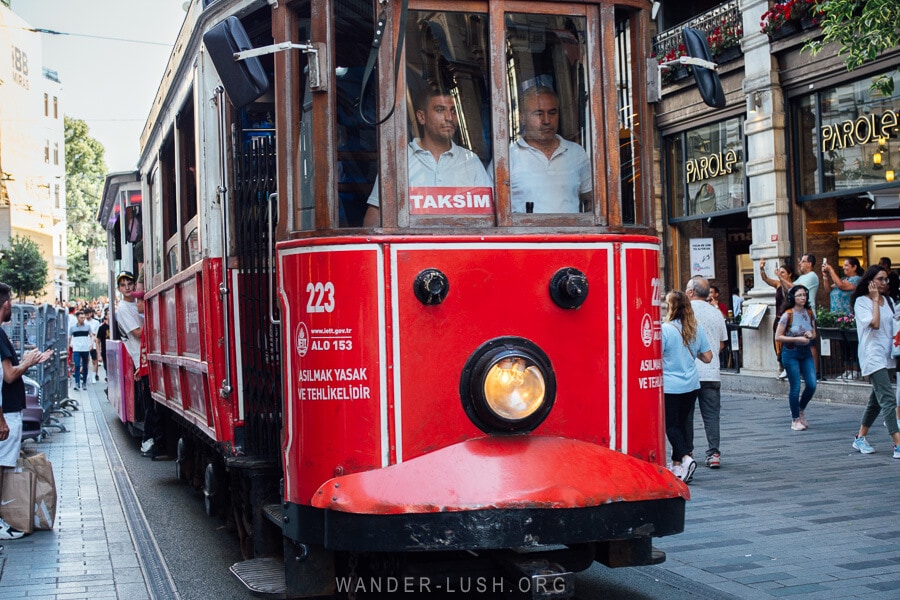
If the mood strikes, indulge in one last treat: A monolithic wedge of havuc dilimi pistachio baklava stuffed with ice cream at Istanbul’s most famous cafe, Hafız Mustafa 1864. There are several branches dotted along Istiklal.
Finish in Taksim Square, the iconic plaza and crossroads of the city, fringed by monuments and mosques. Evening is the best time to make your pilgrimage to Taksim – during the day, the cement reflects the sun and it becomes unbearably hot. Groups of students and friends gather here in the evenings to see the sun down, giving it an upbeat (borderline overbearing) atmosphere.
Turkey essentials
Here are some of the websites and services I recommend for planning a trip to Turkey. Remember to check out my full list of travel resources for more tips.
FLIGHTS: Find affordable flights to Turkey using the Skyscanner website.
VISAS: Use iVisa to check if you need a tourist visa for Turkey and apply for an expedited visa online.
DOCUMENTATION: Use OneWayFly to obtain proof of onward travel/hotel reservation for your visa application.
TRAVEL INSURANCE: Insure your trip to Turkey with HeyMondo, my preferred provider for single-trip and annual travel insurance.
CAR HIRE: Use the Local Rent platform to hire a car from a local agent. Prices start from as little as 18€ per day.
ACCOMMODATION: Find the best Turkey hotel deals on Booking.com.
CITY TOURS & DAY TRIPS: Browse the Viator website to find the best itineraries and prices for Istanbul food tours, Cappadocia balloon rides and more!
More Istanbul travel resources
- 41 Istanbul tips for first-timers
- How much do things cost in Istanbul? Budget travel tips
- Tips for visiting Galata Tower for Istanbul city views
- The best Whirling Dervishes ceremony in Istanbul
- The ultimate guide to Istanbul street food
- Guide to Arnavutkoy, my favourite neighbourhood in Istanbul
- The most beautiful places to visit in Turkey
- Where to go in Turkey in winter